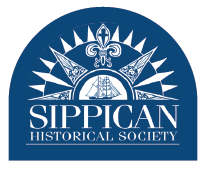Wharves, Wood Shingles & Whaling Captains:
Sippican Village from the 17th to the Early 20th Century
An Architectural Walking Tour of Marion’s Wharf Village
Introduction
Few Massachusetts town centers possess the charm and historic character of Marion’s Wharf Village. Much of its interest stems from its superb waterfront location affording views across Sippican Harbor to the architecturally significant estate houses of Great Neck’s western shore. Over time, hurricanes have damaged and destroyed wharves and buildings associated with Marion’s nineteenth century maritime industries. The town’s historic role as an important port of call and ship building center for the coastal schooner trade circuit, as well as the home of whaling captains, is evident in its rebuilt wharves, including Luce’s, Union, and Central (Long); utilitarian structures such as a sail maker’s shop, cooper’s shop and an ice house; as well as the solid and substantial late 18th – to mid-19th – century houses of seafarers.
The truly remarkable character of Wharf Village is inherent in its dense, unusually extensive, concentration of primarily nineteenth-century residences. This character reflects an informed approach to their historic preservation in terms of appropriate materials and paint colors. Additions to these houses, particularly Capes, in the form of ells and dormers evidently reflect efforts to maximize living space while heightening the already picturesque appearance of these houses. A number of these alterations apparently date to the turn-of-thecentury and are of interest as part of the evolutionary history of these homes. To a certain degree, the architectural significance of Wharf Village is greater than the sum of its parts. Many of its buildings are simple, vernacular buildings whose geometric forms and materials create compelling visual dialogues within streetscapes. In general, noteworthy architectural elements are in evidence at entrances in the form of multilight transoms, pilasters, entablatures and door hoods. The overwhelmingly residential character of this area is relieved by several fine examples of nineteenth- and early twentieth-century ecclesiastical and institutional design. Many of the same qualities that account for the unique character of coastal communities such as Nantucket, Edgartown on Martha’s Vineyard, Provincetown, and Marblehead are in evidence in Marion’s Wharf Village, without the same degree of twenty-first-century commercialization. The historic preservation challenge lies in resisting the temptation to make additions and alterations that might be unsympathetic with the original form, style and feeling of a building.
Wharf Village Walking Tour starts at the headquarters of the Sippican Historical Society, next to the Post Office and across from The General Store.
The headquarters of the Sippican Historical Society, in the Federal/Greek Revival house at 141 Front Street (left), was built in 1834 as the residence of Dr. Walton Nye Ellis. In 1841, Dr. Ellis, one of the ten founders of the Congregational Church, gave $1,000 towards its construction. In 1845, Dr. Ellis was one of five original officers of Marion’s Independent Order of Odd Fellows organized by District Deputy Grand Master William H. Taylor of New Bedford. In addition to his duties as the village doctor, he served for a time as the Republican postmaster of Marion, at a time when this position was a political appointment designated by the President of the United States. In 1855, Dr. Ellis founded Marion’s first public library, which was housed in a second floor closet at 27 Main Street. From the 1860s until the early 1900s, Dr. Ellis’ daughter, Annie, and her husband, Sylvanus W. Hall, lived here. He was appointed Marion’s postmaster by Abraham Lincoln, serving in this capacity for thirty-six years.
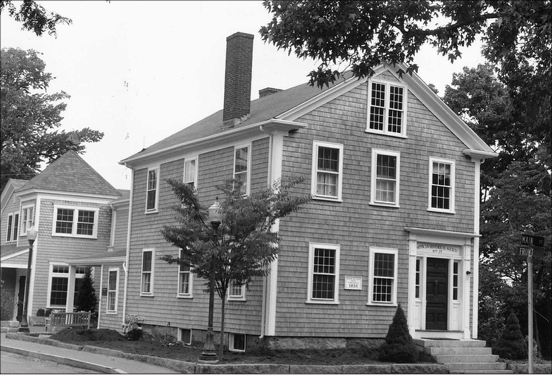
Sippican Historical Society, 141 Front Street
Turn left onto Main Street. Of all this area’s thoroughfares, densely-built up Main Street has the most picturesquely antique appearance. Considering the fact that the hurricanes of 1938, 1944 and 1954 wreaked devastation within Wharf Village, it is miraculous, indeed, that so much of the area’s historic character remains intact. According to a Wareham Courier article dated September 27, 1938, ‘Main Street and the whole waterfront presented a sorry spectacle with its piles of debris and scattered wreckage and huge trees uprooted. All of the buildings on the Wharf are gone and all the boats in the harbor with the exception of two were swept away.” Fortunately, the town did not sustain any loss of life. Damages to the fabric of the Wharf Village area were part of a loss estimated by the town’s Board of Assessors of at least $2,340,860.
The segment of Main Street between Front and Water Street is bordered by five-bay by two-bay Cape Cod cottages, two-story hip and gable-roofed Late Georgian and Federal residences, as well as a Greek Revival facade gable dwelling. Ranging in date from the 1690s to the 1820s, with the majority of houses dating to the first three decades of the nineteenth century, the modest scale of this street’s housing, together with small front yards enclosed by granite block-edged front yards, picket fences and hedge rows, combine to form a compelling image of an orderly, closely knit community.
One of the few full blown examples of the Federal style in Marion is the c.1820 Henry and Tamson Kelley House at 26 Main Street (right). Henry Kelley, together with his brother, Lucius Kelley, owner of 6 Main Street were ship caulkers. During the late nineteenth century, Lucius Kelley inherited this house, naming it “Jennie Bell’s” after his daughter, who married Charles Bell Blankinship. Lucius Kelly is listed as a ‘ship’s caulker’ as late as 1907, and lived here in retirement until his death, c.1917. By 1926, this dwelling had become known as Lena Kelly’s boarding house.
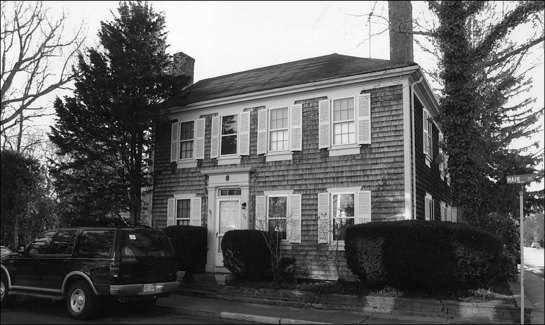
Henry and Tamson Kelley House, 26 Main Street
22 Main Street dates to the 1820s. Built for Captain William C. Hathaway, “the last captain of Marion’s last whaler,” this substantial house attests to the comfortable living available to those who had achieved the rank of sea captain. Captain Hathaway’s ship, The Admiral Blake, made its last voyage in the 1880s. The vessel’s last cargo of oil was unloaded at Long Wharf and hauled to New Bedford by oxen. The Captain’s heirs owned this Federal/Greek Revival house until at least the mid 1920s.
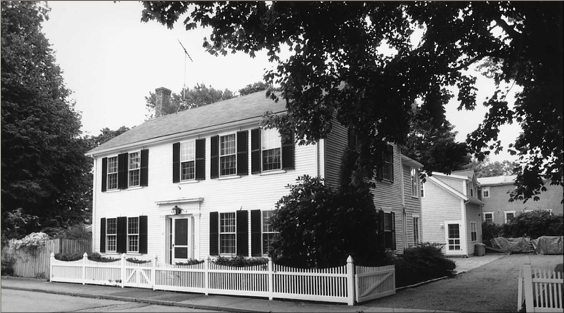
22 Main Street
21 Main Street is reportedly the oldest building in Wharf Village, with interior structural elements that point to a 1690s construction date. Actually a three-quarters Cape, this venerable dwelling is said to have been built for a member of the Ryder family, and was owned by members of the Wing family during the second half of the nineteenth century. By the early 1900s, it was owned by Marion’s Universalist Church.
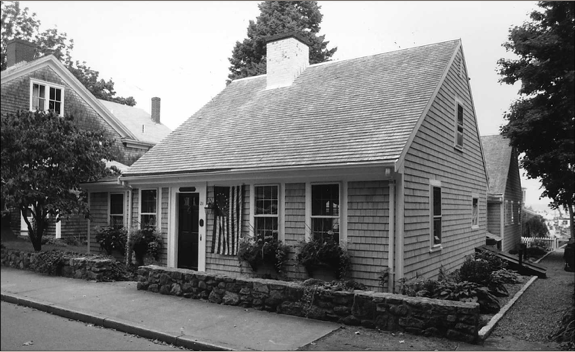
21 Main Street
Representing a late addition to Main Street’s fine collection of historic houses, 17 Main Street is a Greek Revival/ Italianate one-and-one-half-story gable house. It was built for Henry C. Nye in approximately 1860.
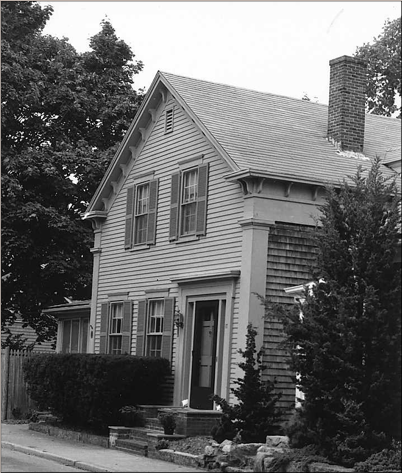
17 Main Street
According to local lore, the early 1800s Cape Cod cottage at 15 Main Street was a stop on the Underground Railroad. During twentieth century renovations, the owner discovered a blocked passageway lined with bricks that previously went from the kitchen to a point under the street. The possibility remains that slaves from the southern states en route to freedom in Canada may have found temporary refuge in this hidden tunnel. The earliest identified owner of this house is Paul A. Briggs, a teamster who lived here during the early 1900s.
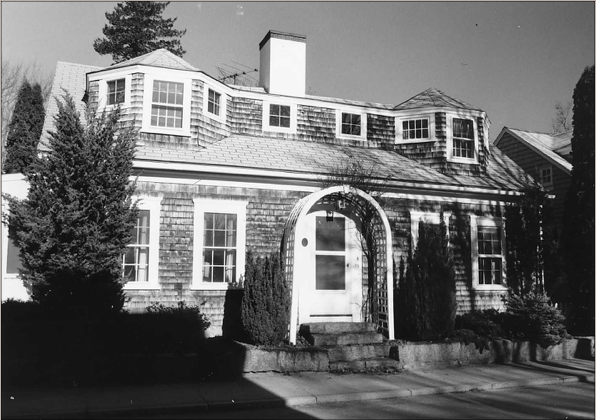
15 Main Street
14 Main Street was built in 1760, before Wharf Village had an architectural identity recognizable as a town center. For the first three-quarters of the 19th century, this Cape Cod cottage was owned by members of the Bates family. At the turn of the century, noted artist and magazine illustrator Charles Dana Gibson lived here. He was the creator of the famous Gibson Girl, which helped to define female fashion during the 1890s.
The Cape Cod cottage is the most widely represented historic domestic architectural style in Marion, as well as Wharf Village. These compact houses were ideally suited for the harsh New England climate and could be easily enlarged to meet the changing needs of families. This style persisted from the late-seventeenth until the mid-nineteenth century. During the first half of the nineteenth century, the standard Cape form could also easily be stylistically updated by creating door and window trimmings reflective of Late Georgian, Federal, Greek Revival and Italianate sensibilities. Around the turn-of-the-century, many Capes were updated by the addition of ells and, especially, dormers that enhanced the picturesque appeal of these dwellings.
In back of this house is a shed that reportedly was a one room school house that was moved from the site of the present Marion Post Office. Tabor Academy’s founder, Elizabeth Pitcher Taber, taught in this school house before her marriage in 1823. At an unspecified date, Miss Roberta Bates and her sister Nancy Bates Crowell kept a “calico and notions” shop in part of this house.
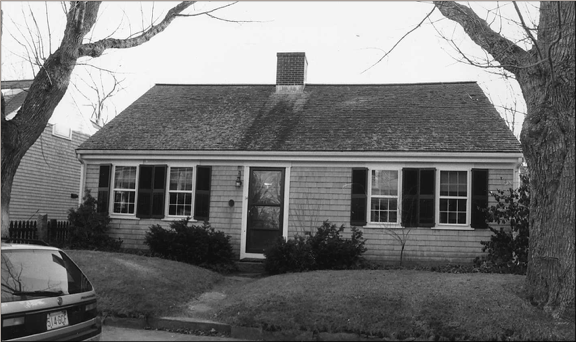
14 Main Street
12 Main Street represents a small, shingled ten footer common in the early nineteenth century. It was built in 1820 for a member of the Blankinship family. At the turn of the century, Richard Harding Davis, the famous war correspondent, rented this home and used it as a club. Known as The Fin de Siecle Club, this dwelling provided a meeting place for artistic and literary figures to socialize and discuss their work.
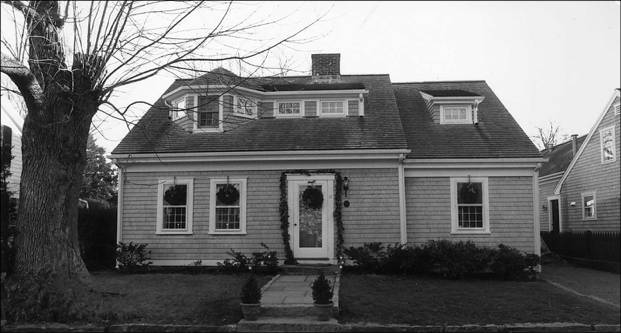
12 Main Street
Erected c.1790, 13 Main Street was owned by members of the Blankinship family during the mid nineteenth century. By the early 1900s, Henry M. Prichard, accountant, lived here. Born in New York City July 31,1845, Mr. Prichard’s father was a merchant. As a child, his family moved to Groton, MA, where he attended Lawrence Academy. During the Civil War, he enlisted in the 25th Massachusetts Volunteer infantry and was part of the Burnside Expedition. According to his obituary in the Wareham Courier (3/13/1913), “he was wounded so seriously at the Battle of Cold Spring Harbor that he never fully recovered.” An “ardent devotee of canoeing”, Mr. Prichard retired to Marion, having spent most of his life in New York City. His widow, Alice M. Prichard, and daughter, Abbie L. Prichard, lived here until the mid 1920s.
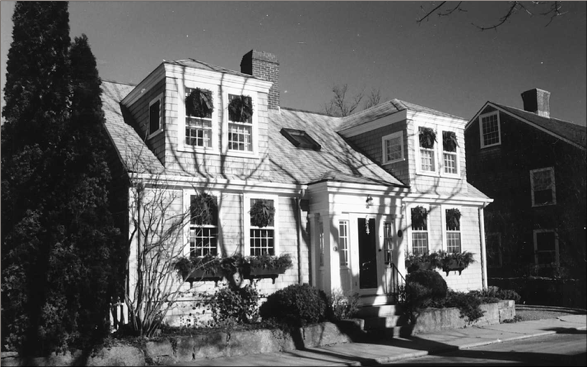
13 Main Street
According to local historian Olive Hiller Somers, 9 Main Street was built in 1780. During the mid-nineteenth century, J. Handy owned this Cape Cod cottage. Benjamin Bowditch operated a boarding house here during the late nineteenth and early twentieth centuries. Bowditch was probably responsible for the dormer additions that would provide more rentable space for his boarders. During the 1890s, famous war correspondent Richard Harding Davis rented two rooms on the west side of the house. Marion historian H. Edmund Tripp identifies this house as Harding’s “workshop”. Davis covered the Boer War in South Africa, as well as early twentieth century hostilities in the Balkans. The author of many short stories and novels, he was a playwright whose successful Broadway plays starred John and Ethel Barrymore, John Drew, Evelyn Nesbitt and Maude Adams; most of these performers followed Davis to Marion.
During the early 1920s, Franklin D. Roosevelt lived at that address while being treated by his friend and neurologist Dr. William Mc Donald. Following his doctor’s orders, Roosevelt subjected himself to strenuous swimming exercises in Sippican Harbor in an effort to regain strength in his legs following an attack of polio in 1921. At an unspecified date, Arctic explorer Admiral Richard Byrd lived here.
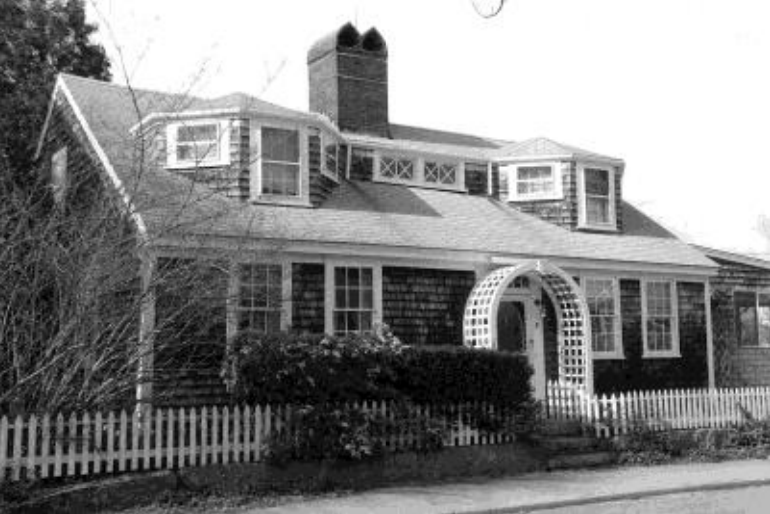
9 Main Street
The late Georgian style residence at 3 Main Street occupies the site of the 1760 J. C. Luce House. Conveniently located near Long Wharf, this 1806 building originally contained A. J. Hadley’s Store. Here, ships were outfitted for voyages. While Hadley’s store occupied the eastern half of the first story, the western segment housed the first Post Office in Sippican. During the early 1800s, clothing is said to have been fashioned on the second floor, while sails were made in the attic. By 1855, this house was owned by Sumner Ryder, who served as the Town Clerk (1856-1858) and later joined the ranks of the Union Army during the Civil War. By 1879, this house was owned by J. Abbott. During the early 20th century, Miss Sarah W. Harwood, possibly the daughter of Admiral Harwood, first rector of St. Gabriel’s Episcopal Church, owned this property.

3 Main Street
Reportedly built in 1813, the House of the Two Captains at 2 Main Street, originally housed Captains Elisha E. Luce and Noble E. Bates. Much of eastern Main Street’s charm is dependent on the presence of this stately house and its picket fence enclosed lot. Particularly note-worthy is the main facade’s center entrance, which exhibits unusually fine surrounds, including fluted Doric pilasters and a pediment enlivened by dentils. The captains used part of the house as a crockery and supplies store. Captain Luce moved into this house shortly after his marriage to Jane Hiller. Captain Elisha E. Luce’s best known ship was the Persia, which made numerous profitable trade missions to the Far East. This house was also the birthplace of the Universalist Church in Marion. During the early 1830s, Universalists met in Captain Bates’ half of the house to organize a religious society and plan the construction of the church. Captain Bates owned Bates Wharf, later Union Wharf, at the foot of Main Street. The Luce and Bates families co-owned this house until the mid-19th century.
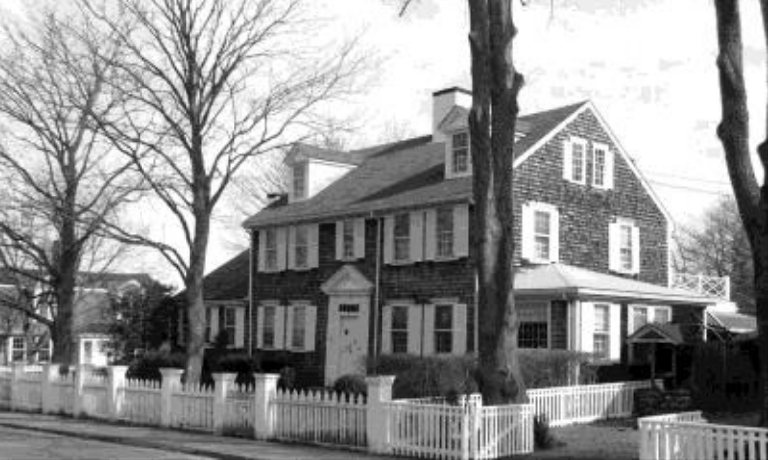
2 Main Street
Before continuing southward to South Street, turn left on to the short extension of Main Street to view some of the earliest surviving structures associated with Wharf Village maritime activities, including a former cooper’s shop, and sail maker’s shops at Bates’ (later Union) Wharf.
Built in 1802, three venerable water front structures are numbered 1 Main Street. Situated on the west side of lower Main Street, the diminutive cooper’s shop originally housed a barrel-making business. Barrels were made in this rectangular, wood shingle-clad, two and one-half story structure. Bound with iron hoops or birch bands so that whale oil could be stored in them, barrels were also made to store cranberries; reportedly, Captain Henry Allen, owner of extensive cranberry bogs as well as a salt works, was one of this shop’s major customers.
On the east side of lower Main Street are two small, rectangular gable roofed structures owned by sail maker James Wittet during the first half of the nineteenth century. Redolent with historic maritime associations, much of Wharf Village’s charm is derived from these modest utilitarian structures. Indeed, cooper shops, sail lofts, ice houses, black smith shops and ship chandler’s buildings charmed and inspired the artistic community that spent summers here around the turn of the century.
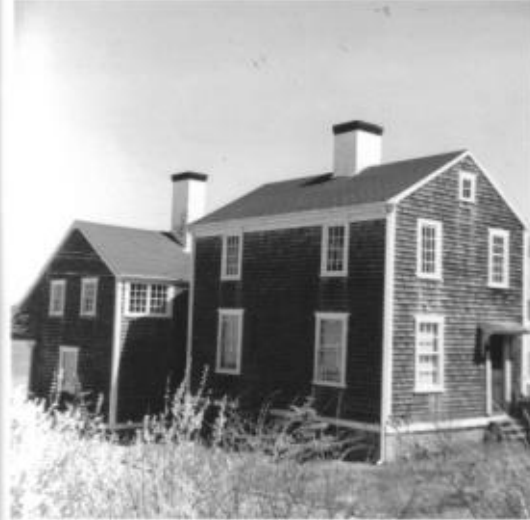
1 Main Street
Continue southward on Main Street’s extension to Water Street. Before turning on right on to South Street; pause to view the Beverly Yacht Club and Sippican Harbor.
The current home of the Beverly Yacht Club at 99 Water Street was built in 1806 as a ship chandler’s store, because of its location near Sherman’s or Central Wharf (later called Long Wharf). By the 1810s, this structure was known as Sherman’s Inn, a stop-over on the Wareham-to-New Bedford stage coach route. By the 1870s, it was the summer residence of Rear-Admiral Harwood, first rector of St. Gabriel’s Episcopal Church. Harwood’s daughter Bessie is credited with encouraging Century Magazine editor Richard Watson Gilder to summer in Marion. During the early twentieth century, it became the home of Dr. William Mc Donald, physician to Franklin D. Roosevelt during the 1920s. Roosevelt sought Dr. McDonald’s medical advice after contracting polio. During the summer of 1921, Roosevelt rented 9 Main Street, undertaking a strenuous routine of swimming recommended by the doctor. The Beverly Yacht Club acquired the building in 1955.
Founded in Beverly, Massachusetts in 1871, the Beverly Yacht Club moved to Wing’s Neck in Bourne at an unspecified date. The club left the North Shore because of an Eastern Yachting Association stipulation that “no boat could race in their regatta unless it was more than 25 feet long.” Evidently, some of Beverly Yacht Club’s members owned smaller boats. In 1914, the opening of the Cape Cod Canal increased boat traffic in Buzzards Bay, off of Bourne, causing the club to relocate to the less frenetic shores of Butler’s Point, Marion.
The Beverly Yacht Club’s “beautiful clubhouse” on Point Road, near the Kittansett Golf Club, was destroyed in the 1938 hurricane. After the storm, the Beverly Yacht Club moved to the present site of Barden’s Boat Yard at Island Wharf, and finally, to its current building at 99 Water Street in 1955.
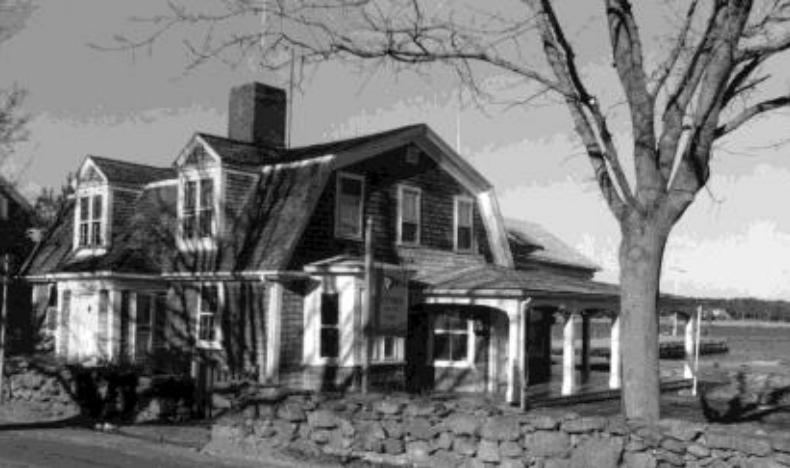
99 Water Street
South Street represents a slightly later, early-to-mid 19th century streetscape of Greek Revival and Italianate houses, with more ample house lots than those of Main Street. From 1864 until the mid-20th century, the eastern entrance to South Street was marked by the large, multi-segmented form of the Bay View House, later the Sippican Hotel. Evolving from a small 1790s residence, its mid-1860s, two-story cupola-topped hotel component was later greatly enlarged by an 1880s three story wing; modern suburban houses presently occupy the site of this famous hostelry.
Blending Greek Revival and Italianate elements, the Lemuel Kelley House at 7 South Street, with its plethora of saw cut brackets, clearly illustrates why the Italianate is sometimes called the “bracketed style.” Measuring five-bays by two-bays, this rectangular residence is clad with clapboards. Built in 1866, the edges of this house are accented by Doric corner boards, while the center entrance exhibits handsome paneled Doric pilasters and a cornice headed entablature enlivened by saw-cut brackets. Additionally, saw cut brackets extend from the main elevation’s fascia boards to its roof eaves. Windows are set off by cornice headed lintels of a type utilized in both Greek Revival and Italianate vernacular design and contain original 6/6 wood sash.
2 South Street (no photo available) is a Greek Revival cottage that was built in 1845 for Captain Russell Grey. During the late nineteenth century, it was the residence of Captain William H. Cobb, the captain of a coastal schooner. Active in community affairs, in 1919 he was a Selectman, Assessor and an Overseer of the Poor. Captain Cobb lived here until his death, c. 1920. His widow, Henrietta Cobb, is listed here in 1926.
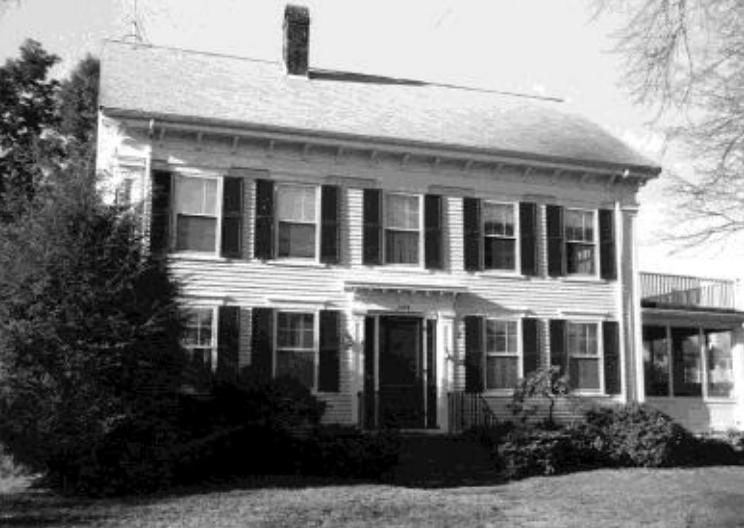
7 South Street
The house at 18 South Street evolved from the small “shop” shown on the 1855 Marion Map. It achieved its present complex form between the mid-1850s and the 1880s. For many years it was the home of “master mariner” Captain Henry C. Lewis.
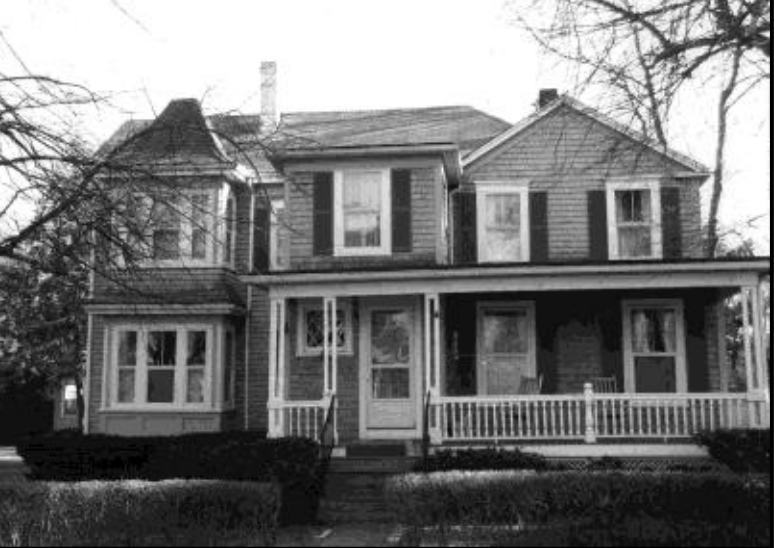
18 South Street
Reportedly built during the early 1800s, 20 South Street may have first been owned by J. G. Luce. By 1879, this house was owned by Charity and Samuel W. Waters. The Waters emigrated from England to Massachusetts around 1820 and initially lived in the 1823 cottage at 80 Water Street, a dwelling which originally stood next to St. Rita’s Rectory at 113 Front Street. By the early 1900s, this property had passed to their son, prominent local businessman Benjamin E. Waters. He was the manager of the local telephone company and had considerable real estate holdings in Marion, including the upscale enclave of Queen Anne and Shingle style residences at Pie Alley. The Benjamin Waters family lived here until as late as 1963.
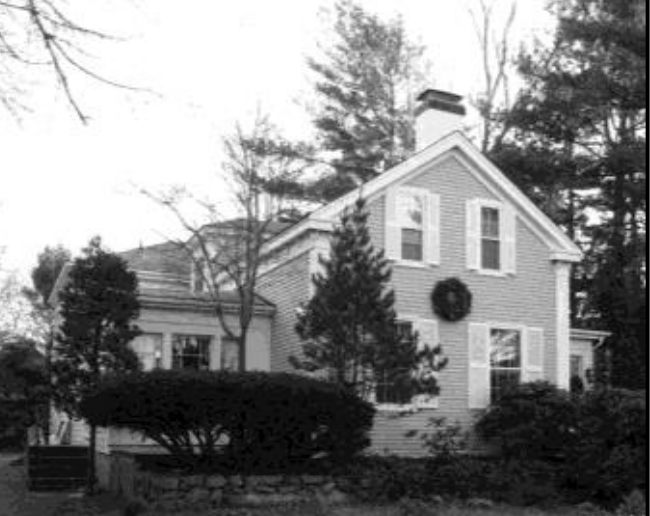
20 South Street
Built between 1830 and 1850, 24 South Street is a Greek Revival house owned by S. C. Luce in 1855. George L. Luce owned this house from the 1870s until at least the first decade of the twentieth century. He was the proprietor of the Marion General Store during the early 1900s. His business is listed as “groceries and dry goods, Main, corner Front.” By 1916, Ida and George I. Luce, a “master mariner” who later became the second assistant to Marion’s fire chief, owned the house.
5 South Street (no photo available) evolved from a structural component said to date to 1799. This Cape Cod cottage’s original owner was Captain Samuel Luce, one of the ten Marion men who contributed $1,000 towards the construction of the 1841 Congregational Church on Main Street. A handsome, full length Colonial Revival dormer addition was added to the main facade’s roof slope during the early twentieth century.
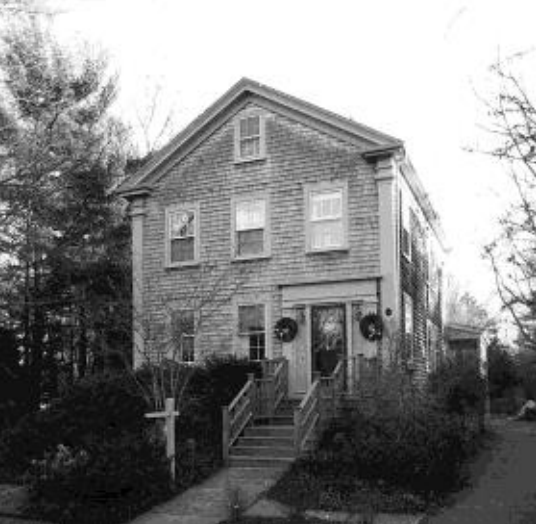
24 South Street
Ranking among the most stylish and substantial examples of the Greek Revival style in Marion, 28 South Street was built in 1841 as a parsonage for Marion’s Congregational Church. The first pastor to reside here was Rev. Leander Cobb. He assisted his father, Rev. Oliver Cobb, who had been preaching in Marion since the completion of the first meeting house in 1799 (now the Marion General Store). After his father’s death in 1849, Rev. Leander Cobb ministered to Marion Congregationalists until his death in 1872.
Leander’s daughter, Sarah Elizabeth, married Captain Benjamin Briggs of Wharf Village in 1862. This couple, along with their children, was lost at sea on the ill-fated Mary Celeste. Together with 24 South Street, next door, this house was owned by the Luces George L. and George I. from the 1870s until the 1920s.
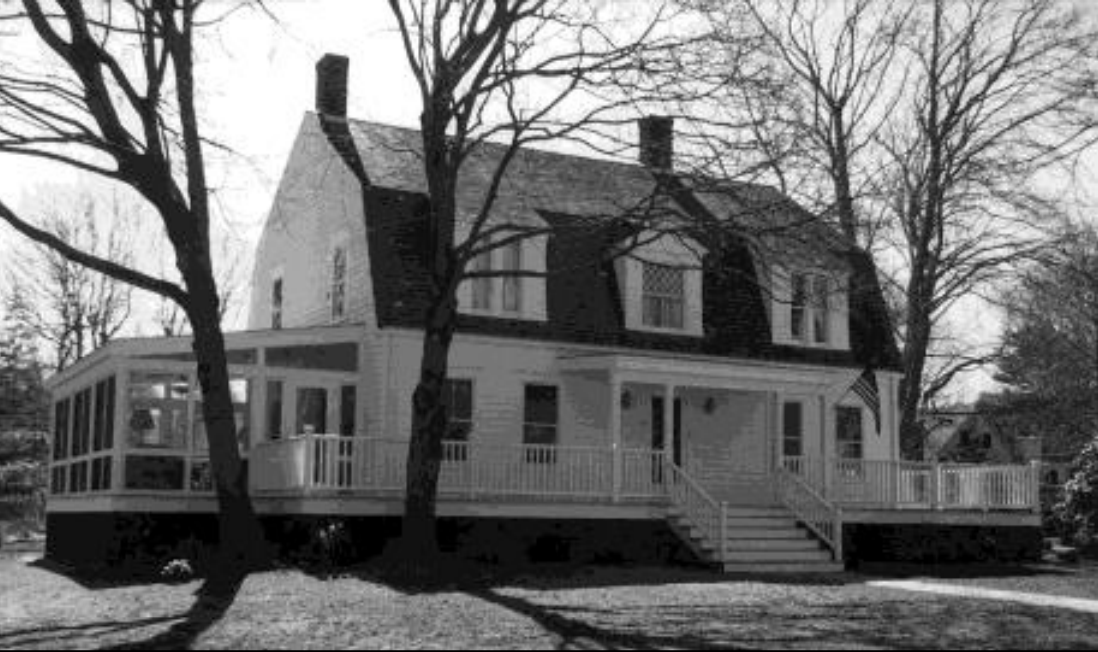
28 South Street
Turning right on to Front Street to Main Street, notice St. Gabriel’s Episcopal Church at the southwest corner of Front and South Street.
St. Gabriel’s Episcopal Church (1874) at 124 Front Street represents a radically altered Greek Revival school building. Built in 1847 as Sippican Academy, a private school for the daughters of whaling captains, its boxy, rectangular, two -story form stood with a pedimented, cupola-topped gable facing South Street. In 1873, this frame building was transformed into a one-and-one-half story Carpenter Gothic, chapel-scale building, which retained the old academy’s projecting, enclosed and gable-roofed entry porch. Rising from the apex of the main facade’s gable is a diminutive stick work belfry. The Chapel contains some distinguished stained glass windows by the Charles J. Connick Studios.
The roots of St. Gabriel’s congregation are traced to the Bay View House Hotel. Here, summer worship services were offered, beginning in 1871. The services were conducted by Rear-Admiral Andrew Harwood, a great-grandson of Benjamin Franklin. In 1872, Rear Admiral Harwood purchased from the Sherman family a permanent home in Marion across the street from the Bay View House hotel. Rear Admiral Harwood continued conducting Episcopalian services in his home until 1874, when he purchased the Sippican Seminary school building at public auction for $700 and converted it into Saint Gabriel’s Episcopal Church. The national press camped out in front of the church in July, 1899, when the celebrated war correspondent Richard Harding Davis married local artist Cecil Clark in a wedding whose guests included illustrator Charles Dana Gibson and actress Ethel Barrymore.
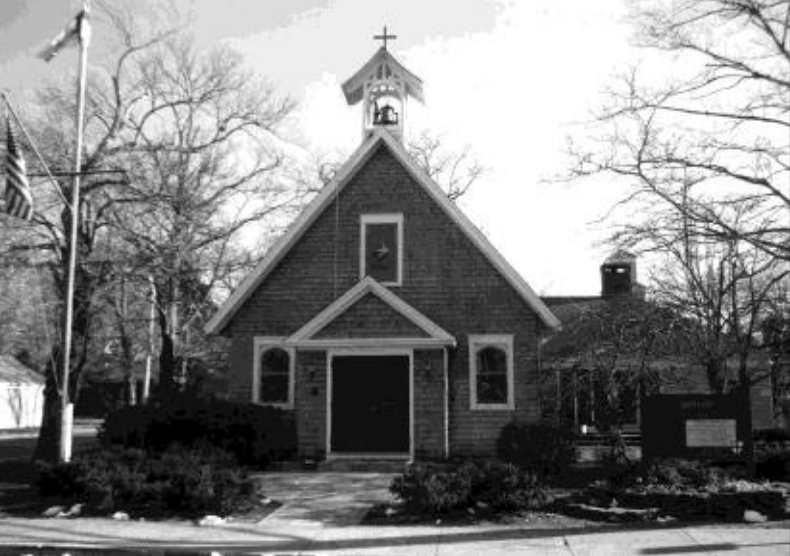
124 Front Street
Continuing northward on Front Street, turn left on to Main Street to admire the Marion Congregational Church.
Much of Wharf Village’s charm is dependent on the presence of the temple form, cupolatopped Marion Congregational Church at 28 Main Street, which majestically presides over the intersection of Front and Main Streets. Designed by Seth Eaton of Mattapoisett, the meeting house was built by local carpenter Silas Allen. The church was built with funding provided by ten area sea captains, who each contributed one thousand dollars toward the construction of the building. Completed in 1841, long after the original 1790s building at 140 Front Street had become inadequate, the church is an unusually fine example of a Greek Revival ecclesiastical building. Measuring three-bays by four-bays, its main entrance opens onto a recessed porch fronted by monumental Tuscan columns in antis. Rising above the pedimented attic is a three-stage, weather vane-surmounted clock tower. Piercing this church’s south wall is a trio of stained glasses windows designed by the important Boston stained glass artist Charles J. Connick during the early 1900s.
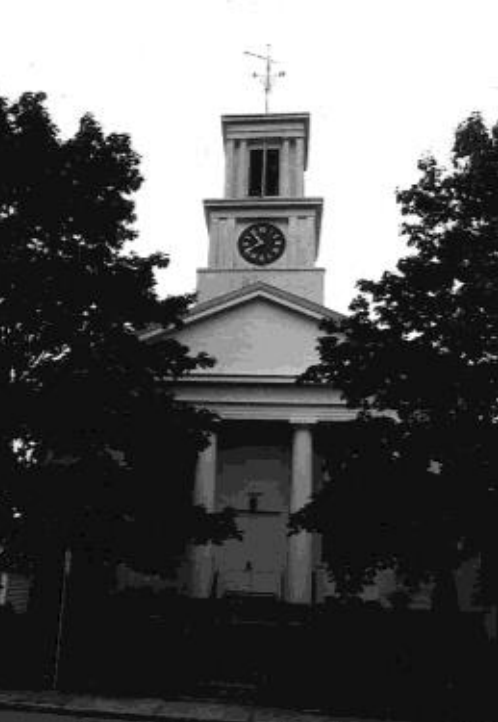
28 Main Street
The 1821 Cape Cod cottage built for Andrew Allen at 31 Main Street reflects the influence of the Federal style still evident in the center entrance’s attenuated paneled pilasters and raised and splayed window surrounds. Built by carpenter Andrew M. Allen, his Allen family owned this house until c.1880.
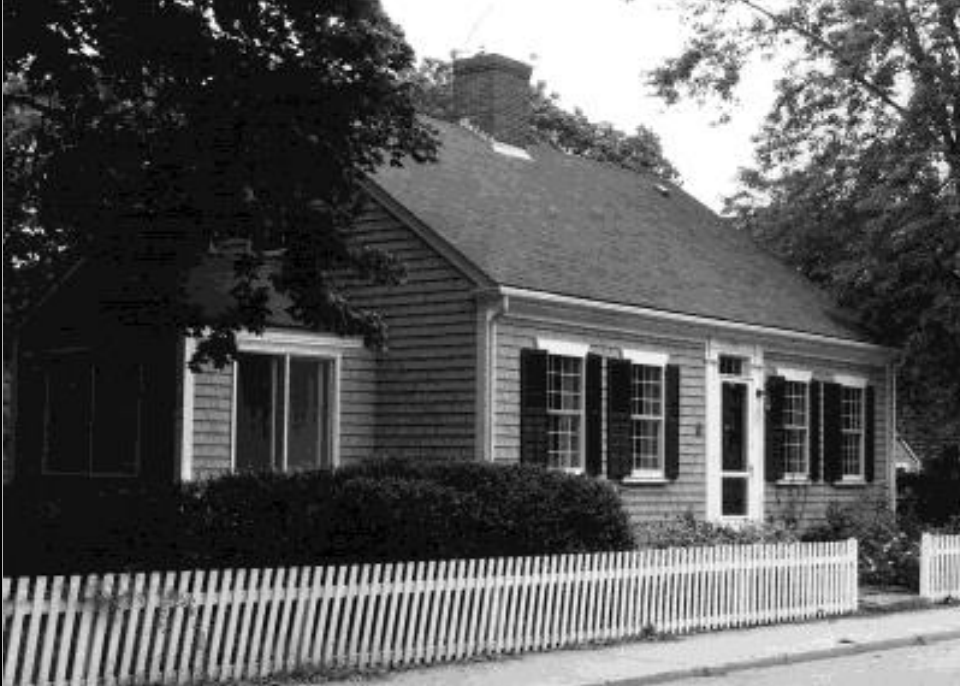
31 Main Street
Reportedly built in 1802, “The Old Salt Box” at 41 Main Street is a late example of a southeastern Massachusetts dwelling with a salt box profile. This house was built for Captain Stephen Hammond, who moved here from 639 Front Street in North Marion. By 1855, Silas B. Allen, carpenter lived here. He was one of ten prominent Marion men who donated $1,000 a piece toward the construction of Marion’s Congregational Church. Allen owned this house as late as 1907 – in that year, he is listed in Marion Directories as “92 years old, boards Mrs. B. M. Hart’s, Pleasant Street.”
More usually associated with late seventeenth century First Period New England houses, its lean-to component projects from the rear wall of this clapboard-clad dwelling, combining with the north gable of the two-story main block to form a saltbox profile. Lester Walker in American Shelter notes that, “adding a single story lean-to shed to the back of a house one-and-one-half or two-story, one room deep house was the most practical method of gaining more space.” The resulting shape of this house was that of a Medieval salt box, hence its name. “In most saltboxes the lean-to addition was divided into three rooms: a central kitchen with its new fireplace and oven; a borning room, reserved for child birth and caring for the ill; and a pantry.” In addition to its distinctive profile, 41 Main Street’s three-bay main facade is noteworthy for its elaborate Late Georgian entrance enframents, consisting of Doric pilasters and a pedimented entablature; much of this house’s charm is derived from these formal entrance treatments, in combination with a modest vernacular dwelling.
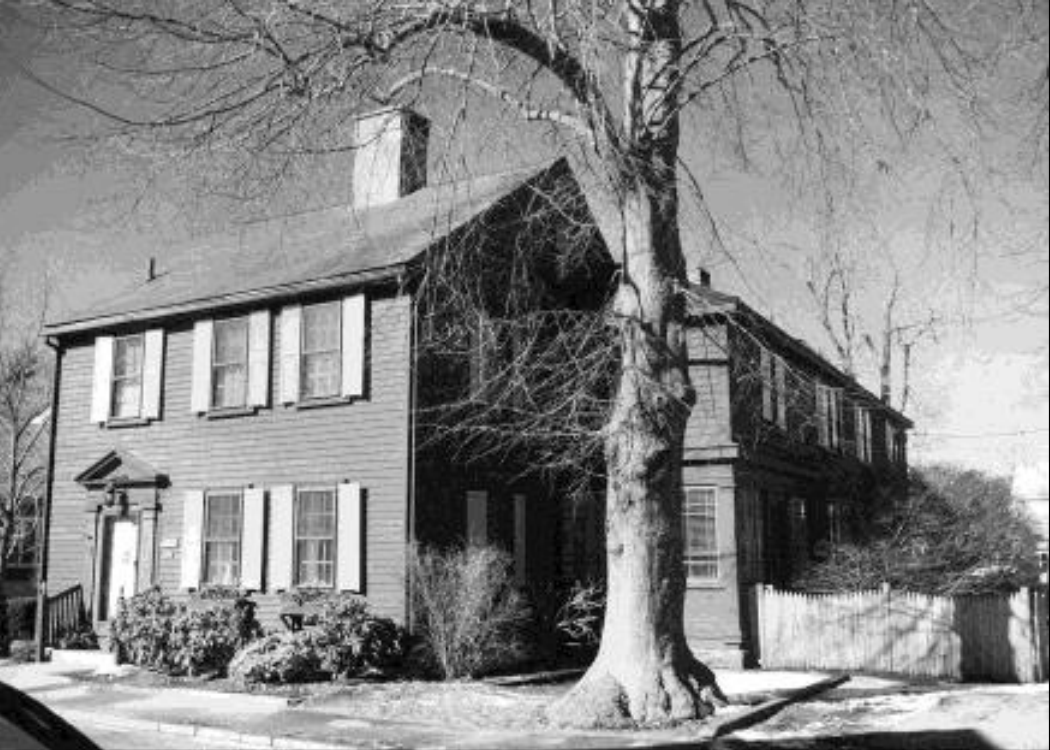
41 Main Street
Built in 1885 from designs provided by Boston architect William Gibbons Preston, The Congregational Chapel at 37 Main Street is a fine example of a Shingle Style ecclesiastical building. Rising a single story from a high rubblestone basement to a gable roof with sweeping slopes, this rustic, wood shingle-clad building is rectangular in form; a distinctive tower with a candle snuffer roof cap is in evidence at its southwest corner. The funding of the chapel’s construction by Elizabeth Pitcher Taber represents the culmination of the Pitcher family’s long involvement in the affairs of the Congregational Society in Marion.
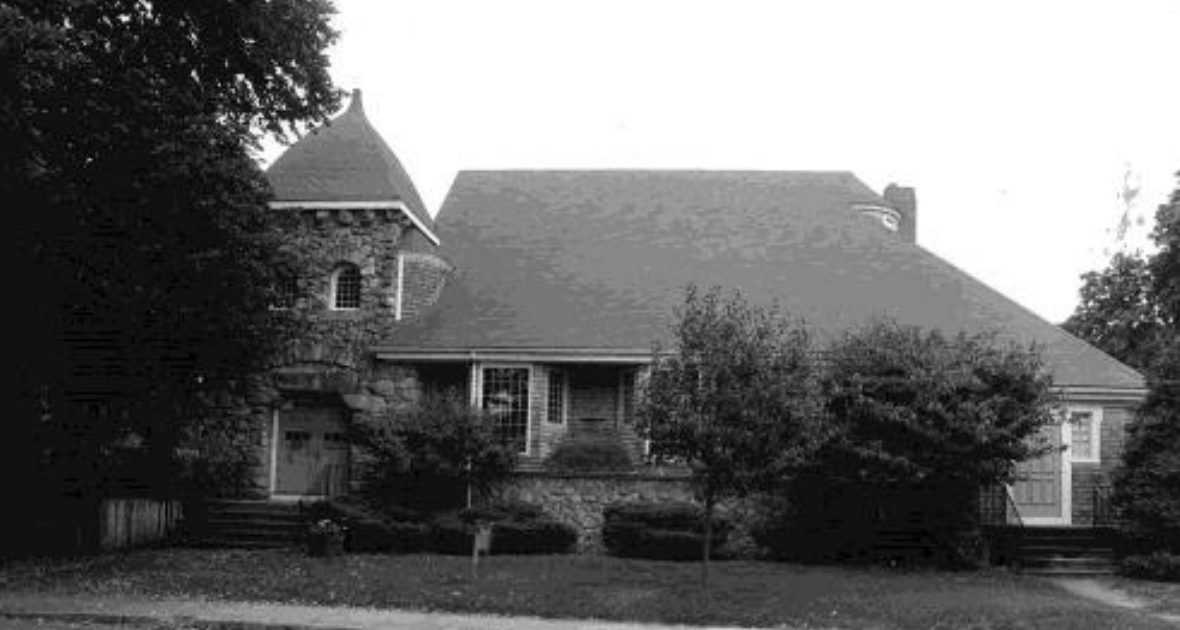
37 Main Street
42 Main Street is a half cape built between 1830 and 1850. This was the home of Josephine Briggs, widow of whaling captain Timothy H. Briggs, from the 1870s to the 1920s.
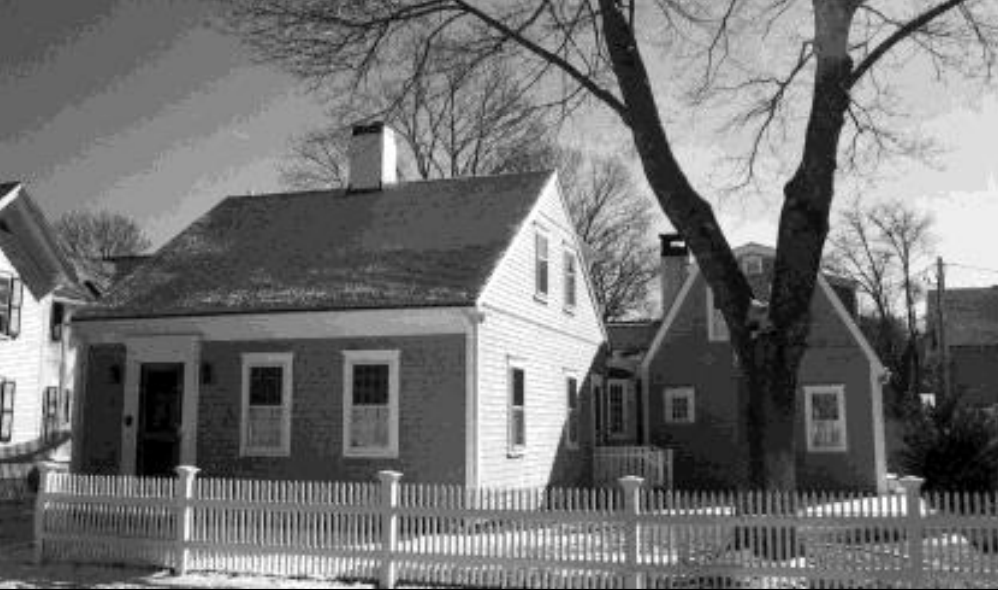
42 Main Street
Built c. 1830 to 1855, the residence at 43 Main Street was originally the third public school in the town center. It may have been built shortly after Marion was incorporated as an independent n 1852.
Main Street west of School Street was set out in 1829. The segment of Main Street between School and Spring Street maintains the density of the earlier, eastern segment, while the house lots between and Mill Streets are more ample. Main Street’s western segment is bordered by examples of the ubiquitous Cape and facade gable Greek Revival cottages, as well as the fairly substantial, asymmetrical forms and more steeply pitched gable roofs of Gothic Revival and Italianate residences.
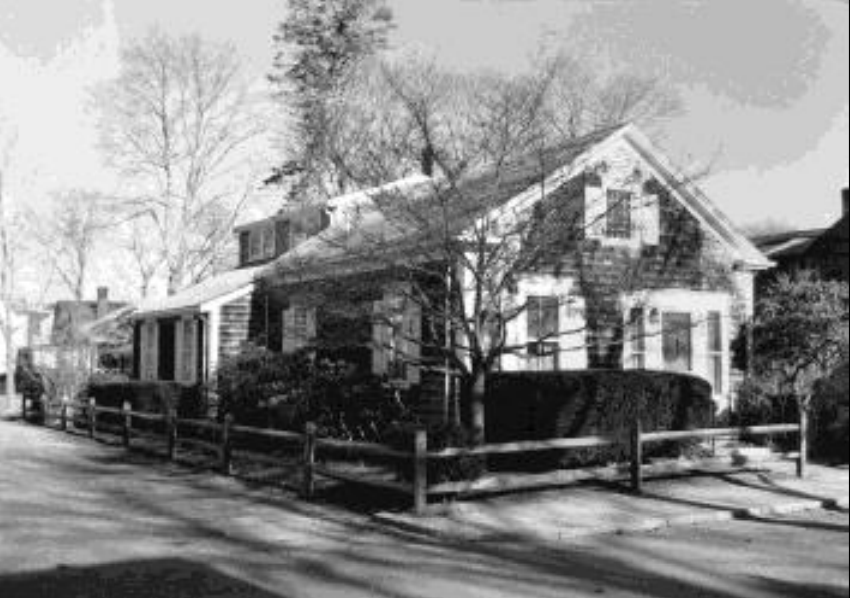
43 Main Street
Overlooking the intersection of Main and School Streets, 44 Main Street was built around 1830. By the 1850s, it was the residence of ship’s pilot George A. Luce. Particularly noteworthy are this Cape Cod cottage’s entrance surrounds. The front door is flanked by simple, well-proportioned Doric pilasters and is surmounted by a multi-pane transom.
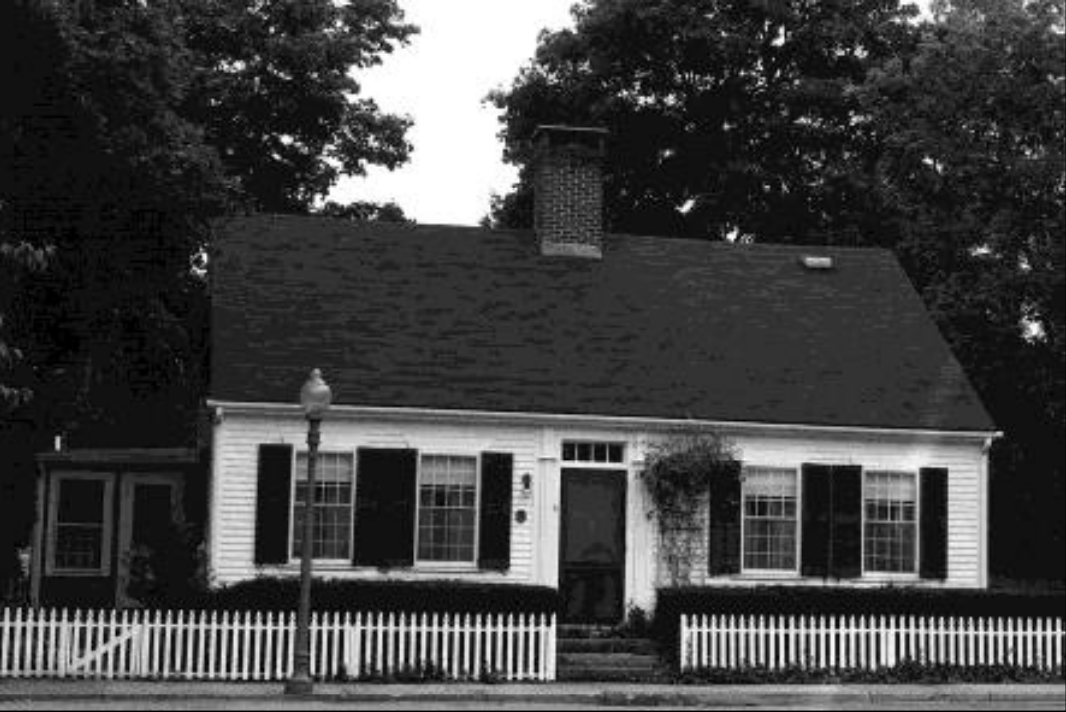
44 Main Street
A plaque on the Cape Cod cottage at 51 Main Street bears a construction date of 1828, indicating that this house was before the formal extension of Main Street to Mill Street to Mill Street in 1829. Built for Kezziah Hiller Look, of Nantucket, and her husband, Captain Hiram Look, this house was owned by B. Coggeshall by 1879. According to his obituary, dated 5/11/1911 in the Wareham Courier, Coggeshall was “a Marion businessman and native of Tiverton, Rhode Island where he was born a little over seventy years ago. A widely known businessman having conducted a store for over twenty years, he was prominent in the Universalist Church, the Evergreen Cemetery Association Corporation and was a member of the Pythagorean Lodge for many years.” This cottage was inherited by his widow and two children, Mrs. A. B. Vose and Frank V. Coggeshall.
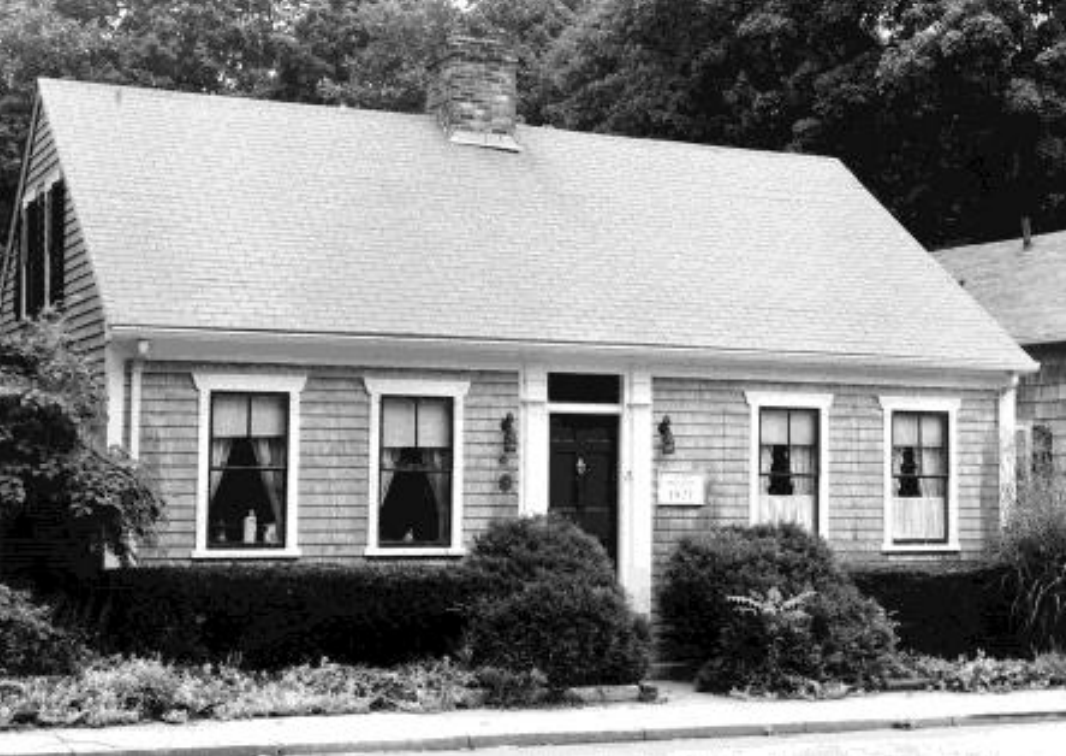
51 Main Street
Built c. 1845 -1855, 54 Main Street is a rare Marion example of a Carpenter Gothic residence. This house has significant historical associations with families engaged in agricultural pursuits. In 1855, this house was owned by John B.B. Nye, proprietor of the Marion Strawberry Gardens and John B. Blankinship, farmer. During the early 1900s, market gardener Henry C. Nye owned this property. By 1916, Nye was the treasurer and tax collector for the town. He married Sarah Cole Nye in 1866. Born in Rochester in 1844, Mrs. Nye was the daughter of John Cole and Mercy Le Baron. With the exception of a few years in New Bedford, Mrs. Nye spent her entire life in Rochester/Marion. She was a direct descendant of Francis Le Baron who, seven generations earlier, had settled in Plymouth Colony, where he practiced medicine. Mrs. Nye died in 1938 at the age of 95 (Wareham Courier Obit. 10/13/1938). Her daughter, Miss Helen C. Nye, bookkeeper, inherited 54 Main Street.
Popular between 1840 and the Civil War, the Carpenter Gothic Revival style is minimally represented in the houses of Wharf Village. Here and there, steeply pitched gables and/or a pointed arched window nod to this antebellum architectural mode. More than any other individual, Hudson River Valley-based landscape architect and cultural critic Andrew Jackson Downing peaked an interest in this style via illustrations and accompanying text in a series of builders’ guides such as Rural Residences (1837) and the Architecture of Country Houses (1850). Typically the favored style of America’s landed gentry, the Gothic Revival or its even more vernacular cousin, the Carpenter Gothic style, may have been too exotic for the practical, hard working fishermen and farmers of Wharf Village.
57 Main Street (no photo available) was built for, and probably by, Noah Handy, carpenter, in 1844. By 1900, this house had been inherited by his daughter, Cynthia M. Handy, who converted her home into a lodging house called the Handy Inn. Miss Handy lived here until at least the mid 1920s.
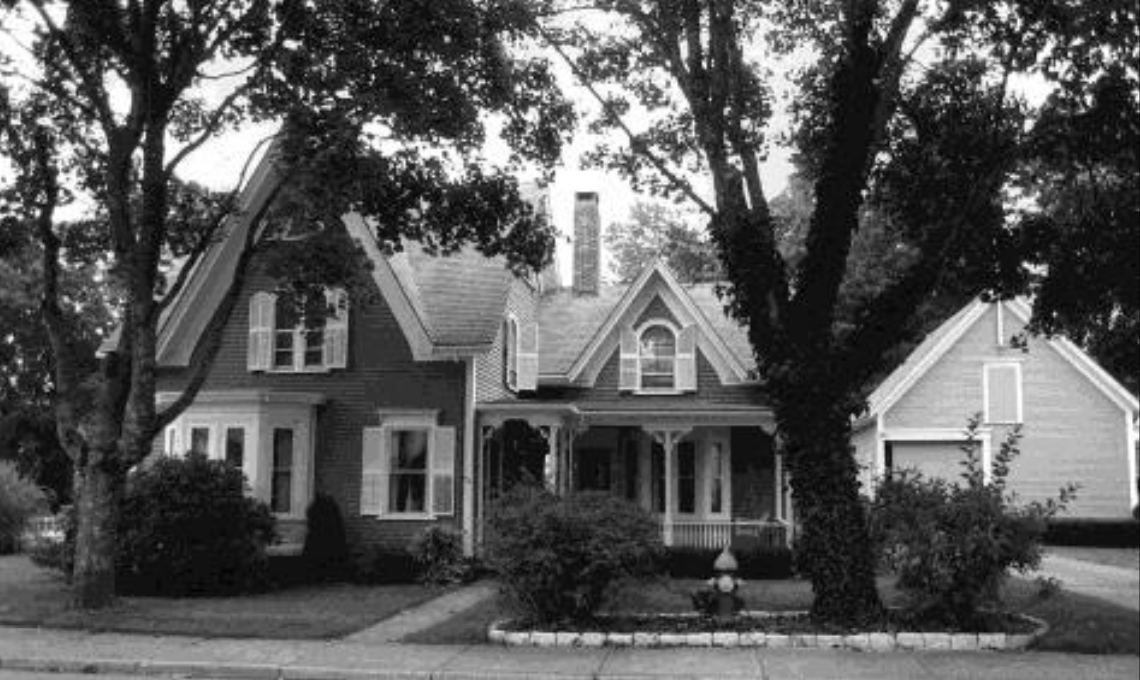
54 Main Street
Before continuing westward along Main Street, pause to view the historic buildings at the northern end of Pleasant Street.
Blending boxy, rectangular Greek Revival form and Gothic Revival elements, the former Universalist Church at 80 Pleasant, now the Marion Art Center, was built in 1833 from designs provided by Seth Eaton of Mattapoisett. This building is historically significant as the spiritual home of Marion Universalists for over 100 years. The original congregation included members of the Clark Bassett, Bates, Blankinship, Foster, Martin, Southworth, and Wing families. Since the late 1950s, the Universalist Church has served as the Marion Arts Center, an active venue for exhibitions and the performing arts.
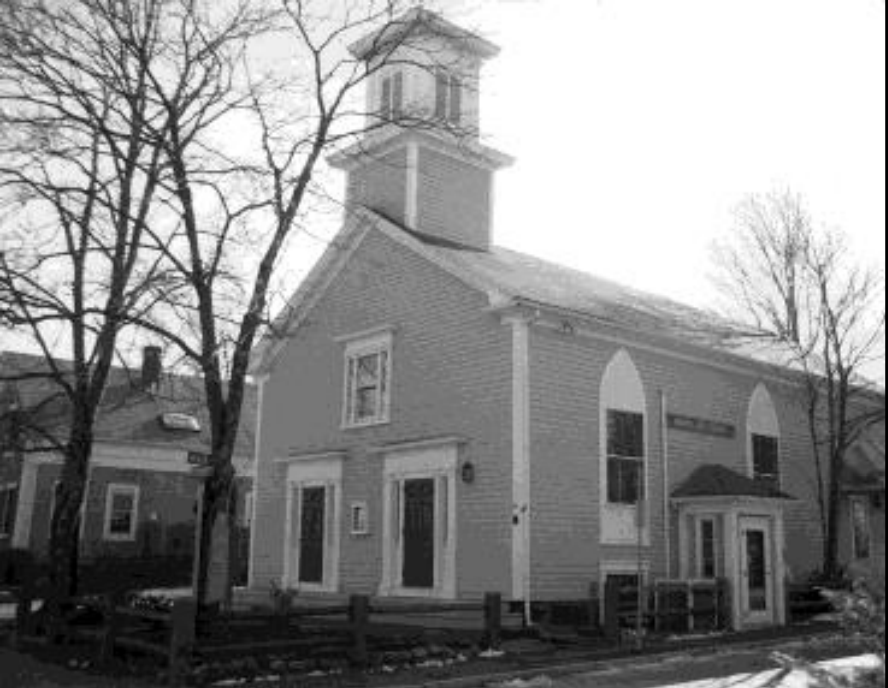
80 Pleasant Street
Together with the church, the former Universalist Church Parsonage at 78 Pleasant Street provides a picturesque vignette of mid-1830s Jacksonian America. Built in 1833, the parsonage ranks among the town center’s earliest example of the one and one-half story facade gable Greek Revival cottage. Still intact are boldly rendered Greek Revival entrance enframents, including Doric pilasters and a molded and cornice headed entablature. In addition, typically Greek Revival paneled pilasters accent the corners of the building. Evidently, this dwelling ceased to serve as a parsonage around c.1950 when the low enrollment of parishioners caused the Universalist Society to disband.
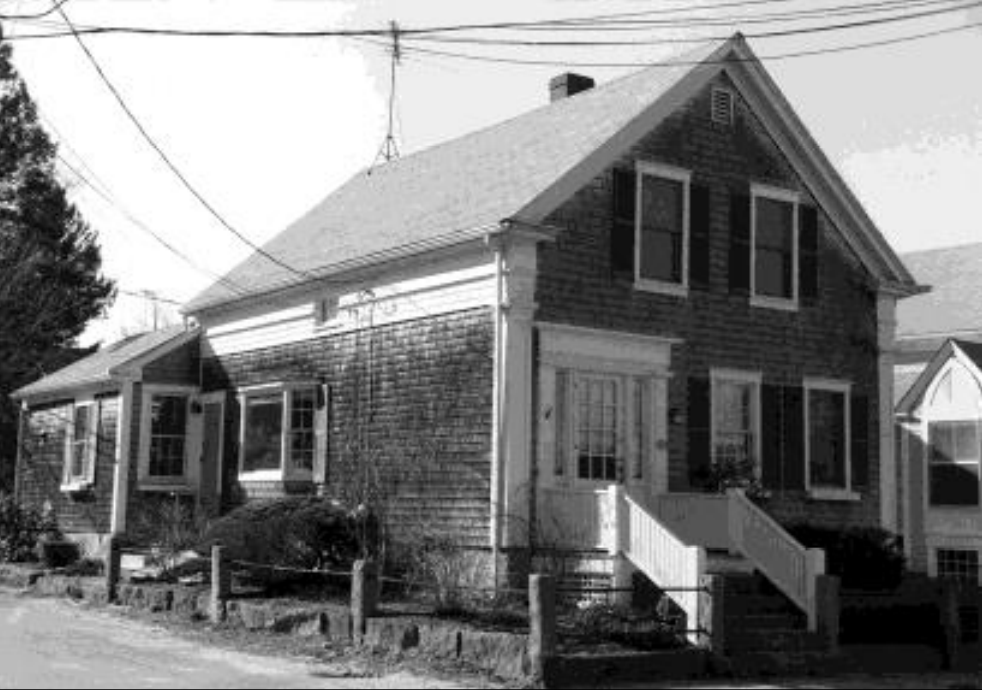
78 Pleasant Street
The Federal vernacular cottage at 73 Pleasant Street was built c.1790 for members of Marion’s Handy family. From the late 1700s until the early 1900s, Pleasant Street north of Pitcher was essentially a Handy neighborhood with a number of dwellings in this area associated with this family. During the mid-19th century, Pardon Handy, carpenter owned this cottage. By the late 1870s, James W. Blankinship, mariner, lived here. He enlisted in the Union army during the Civil War. By the early 1900s, this house had been inherited by Blankinship’s widow Sussannah. Additionally, Lucy A. Blankinship, clerk, lived here.
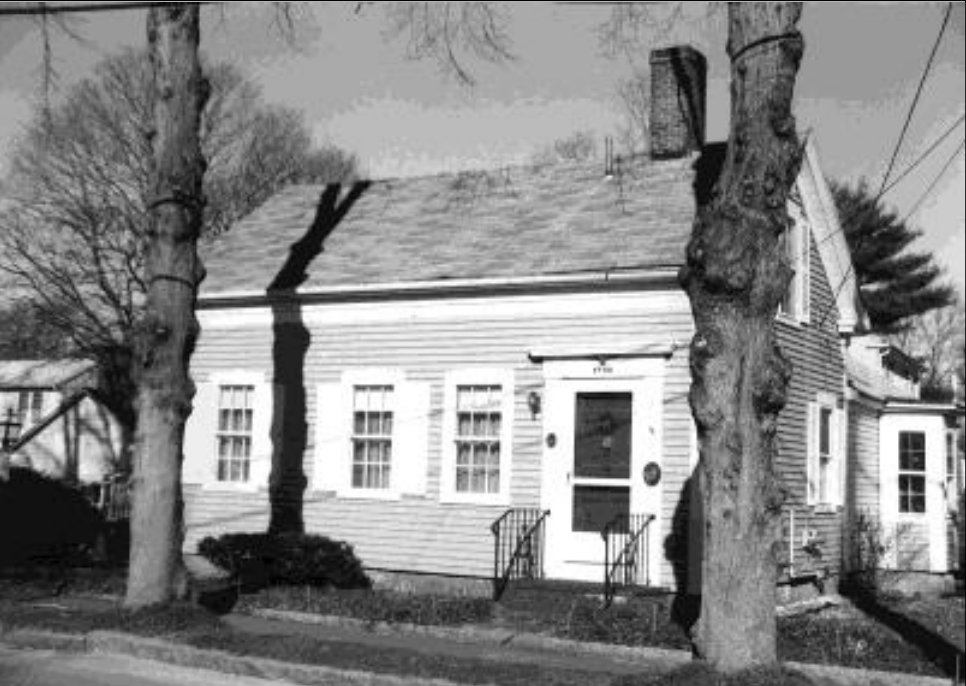
73 Pleasant Street
Returning to Main Street, walk to the intersection of Main and Spring Street. On the west side of Spring Street is the original campus of Tabor Academy. Spring Street started out as a country lane leading to the stone storage facility associated with Captain Allen’s salt works.
The Marion Town House at 2 Spring Street, now the seat of local government, started out as one of Tabor Academy’s original buildings. Mrs. Taber purchased the rock-strewn land on the west side of Spring Street in 1871 from Captain Henry M. Allen. Designed in the Italianate style and built in 1875-1876, this building originally served as a recitation or classroom building. Tabor Academy opened on September13, 1877 with 21 students in attendance. The school was founded by Elizabeth Pitcher Taber, a native of the town who became Marion’s great benefactress, focusing her philanthropic efforts on the Congregational Church and the Academy. Mrs. Taber insisted that the Academy’s name be spelled differently from her own for reasons of modesty and the fact that a Bible story took place at Mount Tabor in the Middle East. During the 1890s, a substantial addition was added to the rear of the building.
During the 1930s, the “Tabor Swap” resulted in an exchange of land between the Town and the Academy. The school’s ten acre Spring Street campus was exchanged for three harbor side acres on Front Street containing the early 1890s Town Hall (demolished) and other buildings.
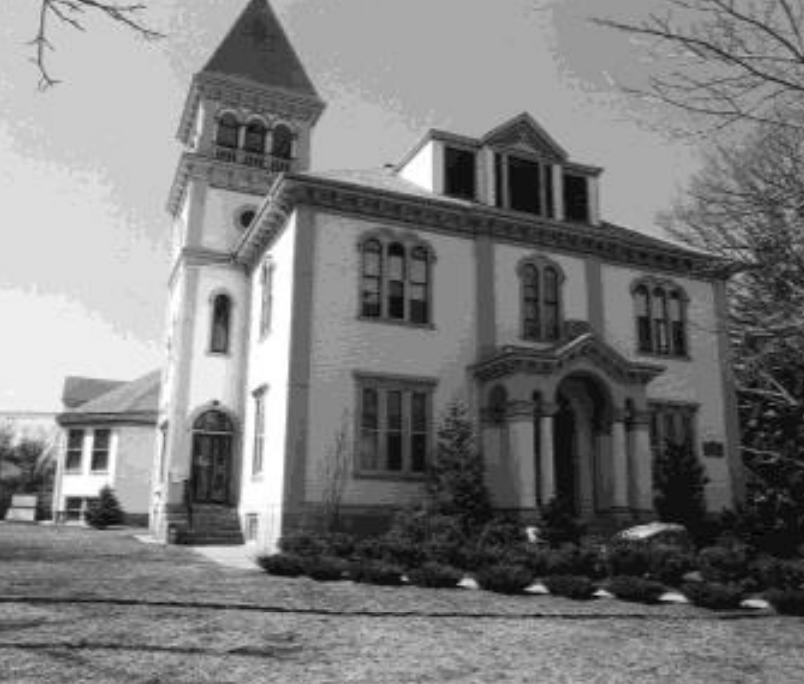
2 Spring Street
The Elizabeth Taber Library and Natural History Museum at 8 Spring Street was built in 1872, the first of numerous gifts of buildings to the town by Mrs. Taber. She stated that her gift represented “a testimonial of my esteem and kind regards for the Library Association and Natural History Society and for the inhabitants of Marion, generally.” Designed in the Italianate style, this cupola-topped building was a key component within the old Spring Street campus of Tabor Academv.
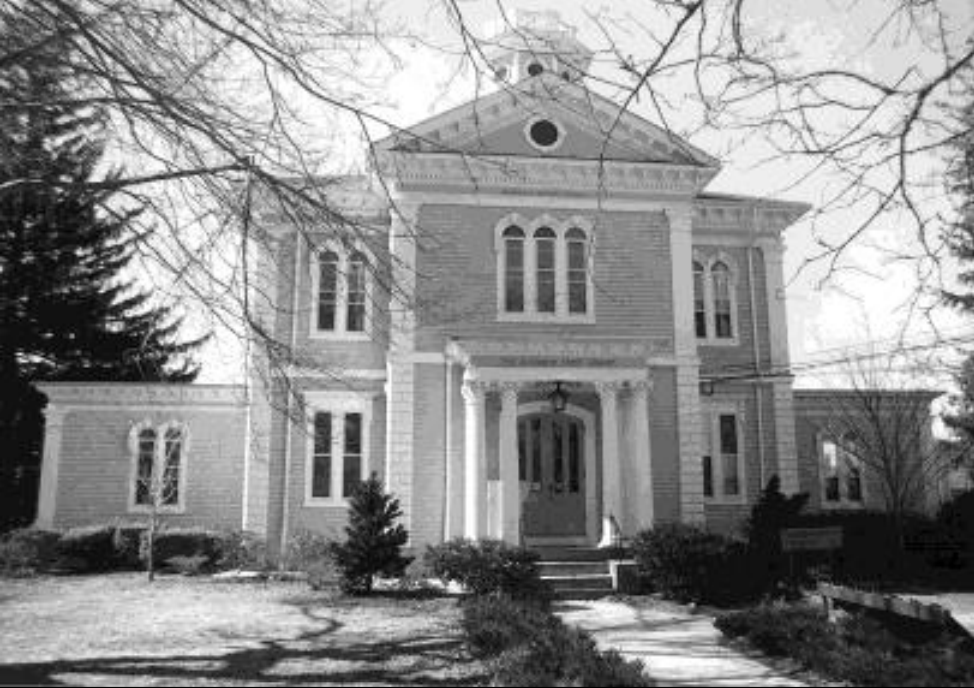
8 Spring Street
The Sippican School at 16 Spring Street was built in 1930 on part of the land included in the ‘Tabor Swap”. Constructed of yellow brick, this grammar school’s design blends the Colonial Revival and Art Deco styles.

16 Spring Street
Situated at the southeast corner of Spring and Cottage Streets is the boxy, two and one-half story form of the Colonial and Classical Revival, Pythagorean Hall (1909-1913) at 11 Spring Street. Representing a relatively late addition to Wharf Village’s varied collection of institutional buildings is Pythagorean Hall, which was built with funding provided by the heirs to the Converse rubber fortune, who summered at their Converse Point estate, called The Moorings. This long rectangular two-story frame building artfully blends elements of the Classical and Colonial Revival styles. Pythagorean Hall was the first major Marion institutional building to have been electrified from the very beginning.
For many years Pythagorean Hall had been housed in a Greek Revival building just to the south of Burr’s Boat yard in the Old Landing area. Its mid-nineteenth century membership was composed of aging sea captains who combined socializing with charitable endeavors benefiting the community. By all accounts, the captains resented the growing influence of philanthropist Elizabeth Pitcher Taber in Wharf Village. The construction of Pythagorean Hall symbolized the fact that community leaders in Wharf Village, not the Old Landing, were shaping the destiny of the town, a state of affairs that had been recognized for twenty or thirty years.
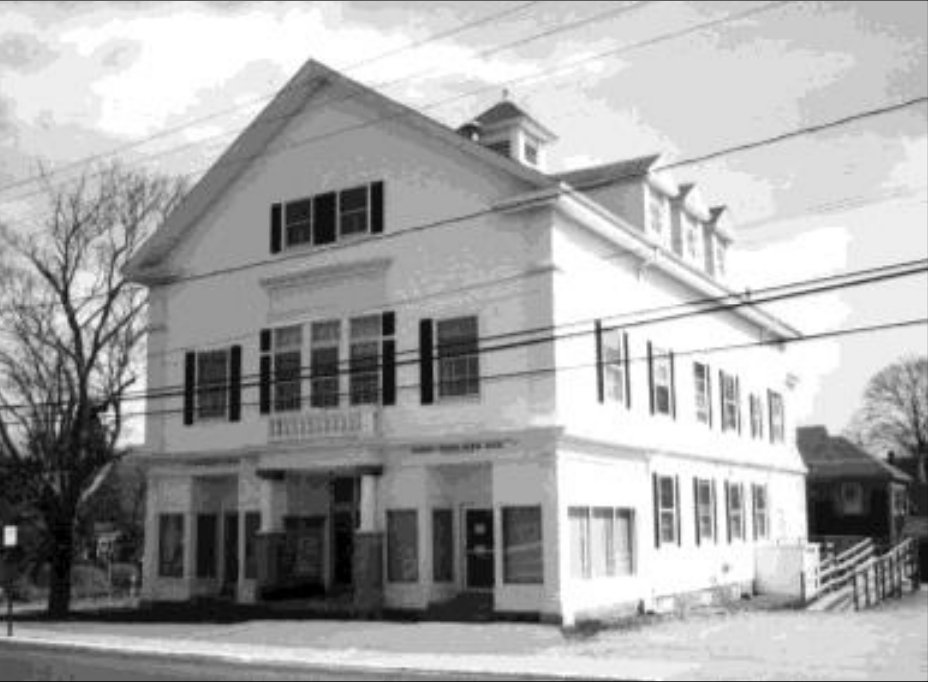
11 Spring Street
Before turning right on to Cottage Street, a slight detour is recommended — continue northward along Spring Street to the stone structure at 46 Spring Street.
Arguably the building with the most national significance in Marion, The Old Stone Studio was built around 1820 as a storage facility for salt and other products. During the early 1880s, Richard Watson Gilder, editor of the widely-read Century Magazine, and his sculptress wife recognized the picturesque charms of this utilitarian structure and purchased it for her studio. Here, the Gilders held court before a colorful array of friends who included illustrator Charles Dana Gibson (creator of the Gibson Girl), war correspondent Richard Harding Davis (“the Dan Rather of his day”), Sanford White (the noted architect who designed the Studio’s great mantle piece) as well as Francis Folsom Cleveland (First Lady of the United States). The Grover Clevelands summered in Marion during the late 1880s and early 1890s, even naming one of their daughters after the town. While President Grover Cleveland fished in Sippican Harbor, Mrs. Cleveland enjoyed poetry readings and theatricals performed at the Old Stone Studio by actors Joseph Jefferson, Ethel Barrymore and others.
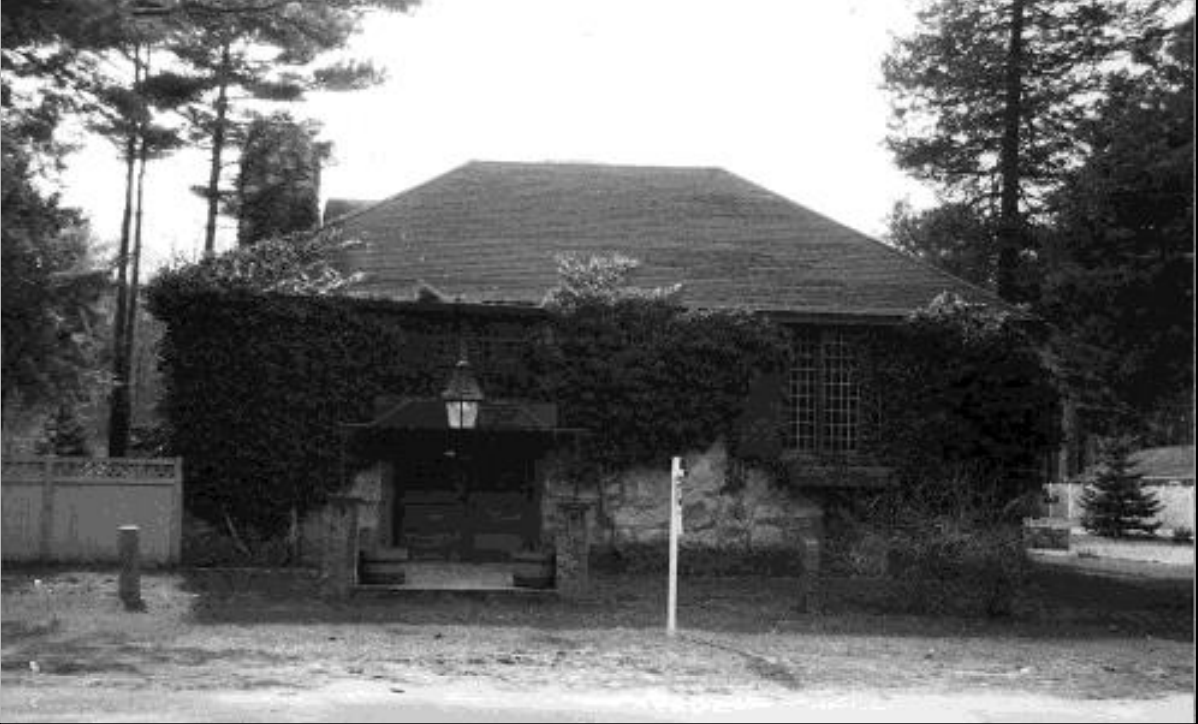
46 Spring Street
Returning to Cottage Street, turn right and continue eastward towards the waterfront.
Set out during the 1880s, Cottage Street runs eastward from Spring Street to Front Street. Unlike Main Street, Cottage Street is wider and its houses’ lots more ample, reflecting the expansiveness of a town that had become a favorite with privileged turn-of-the-century seasonal visitors. This was a departure from its roots as a tightly knit and more densely built-up community at the harbor’s edge, its inhabitants’ livelihoods derived from maritime activities.
During the first half of the nineteenth century, most of the land bordering Cottage Street was part of Captain Henry Allen’s Salt Works. Mrs. Taber’s purchase of land for her Academy during the mid-1870s, in the vicinity of Spring and Cottage streets, signaled the beginning of the Allen tract’s subdivision. Cottage Street may have started out as a path providing Tabor Academy students more direct access from the school’s old Spring Street campus to the water front.
The compact, c. l890s Queen Anne houses at 34 (photo not available) was built for Emma and George F. Hardy, painter and paper hanger. The 1890s Queen Anne house at 36 Cottage Street was built for Russell G. Grey, painter. The Handy family owned number 34 until at least the 1920s. [deleted text] As a young boy, Russell G. Grey, the son of Captain Russell Grey, grew up in the 1845 Greek Revival cottage at 12 South Street. The Greys resided at 34 Cottage Street until c. 1920. Interestingly, a photograph of this relatively modest house was included along with images of more substantial Shingle Style residences in Perry’s early 1900s souvenir guide book, Trip Around Buzzard’s Bay.
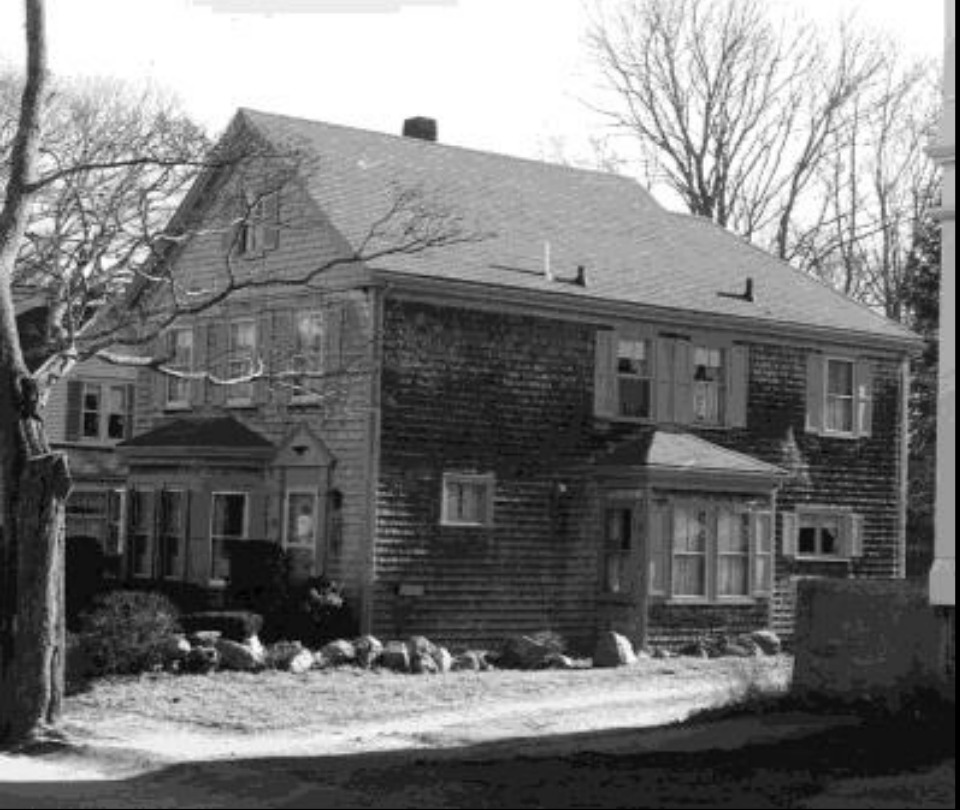
36 Cottage Street
The clapboard and wood shingle clad William Kelley House at 29 Cottage Street is an example of a c. 1890s towered Queen Anne house. Deftly blending Shingle style gambrel profiles with Colonial Revival porch elements and Palladian attic window into its complex, asymmetrically massed form, this house is encircled by a charming verandah. Captain Kelly retired to this house after a successful career as a master mariner.
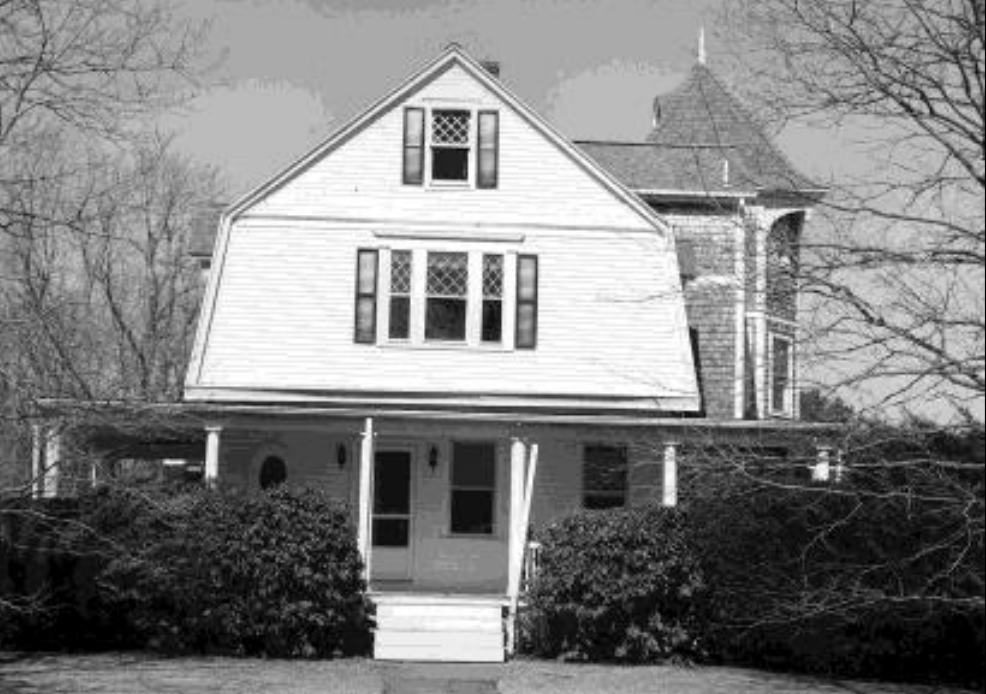
29 Cottage Street
Built during the 1890s for real estate agent Harvey W. Everest, 28 Cottage Street blends characteristics of the Queen Anne Shingle and Colonial Revival styles. The house’s five-bay by five-bay volume is clad with clapboards and enclosed by a broad gambrel roof. The original open center porch exhibits chamfered posts which support the flat porch roof’s simple molded entablature. The design of later flanking porches as well as an enclosed east porch complements the original porch.
22 Cottage Street (photo not available) is situated at the south west corner of Cottage and School streets. A handsome, example of a substantial Queen Anne / Colonial Revival residence, number 22 was built for Florence and Walton S. Delano during the 1890s. He commuted from Marion to Wareham, where he was employed by A. S. Gurney and Company, “dealers in coal, grain and flour.” The Delanos lived here until at least the mid-1920s.

28 Cottage Street
The Italianate style, popular in America between the late 1840s and early 1880s, is represented in Wharf Village by isolated trim elements, rather than in forms such as the towered Italianate villa or cubic shapes associated with this style. One of the most emphatically Italianate buildings in the town by virtue of its distinctive, cupola-topped form and saw-cut elements is Taber Hall at 13 Cottage Street. Built in 1880, its first floor was the residence of Yale University graduate Clark P. Howland, Tabor Academy’s first headmaster. The second story contained the living quarters of the Academy’s founder, Elizabeth Pitcher Taber, who lived here until her death in 1888 at the age of 97. This house was moved from the former Tabor Academy campus on Spring Street to Cottage Street in 1937.
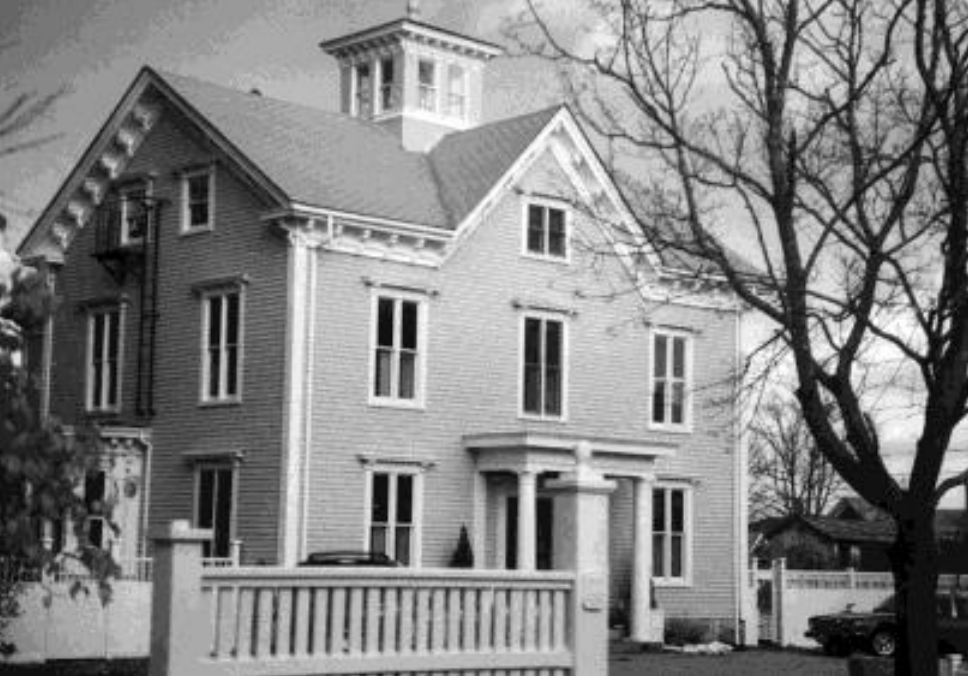
13 Cottage Street
During the 1870s, 9 Cottage Street’s lot was part of a large undeveloped parcel owned by Marion grocer A. J. Hadley. Built during the 1890s for village physician A.W. Rice, 9 Cottage Street ranks among the finest examples of the Queen Anne style in Marion. This charming house has all of its interior woodwork preserved. By the mid 1920s, this house was owned by Viggo Peterson, who sold Peterson’s Ice Cream from the rear of this house.
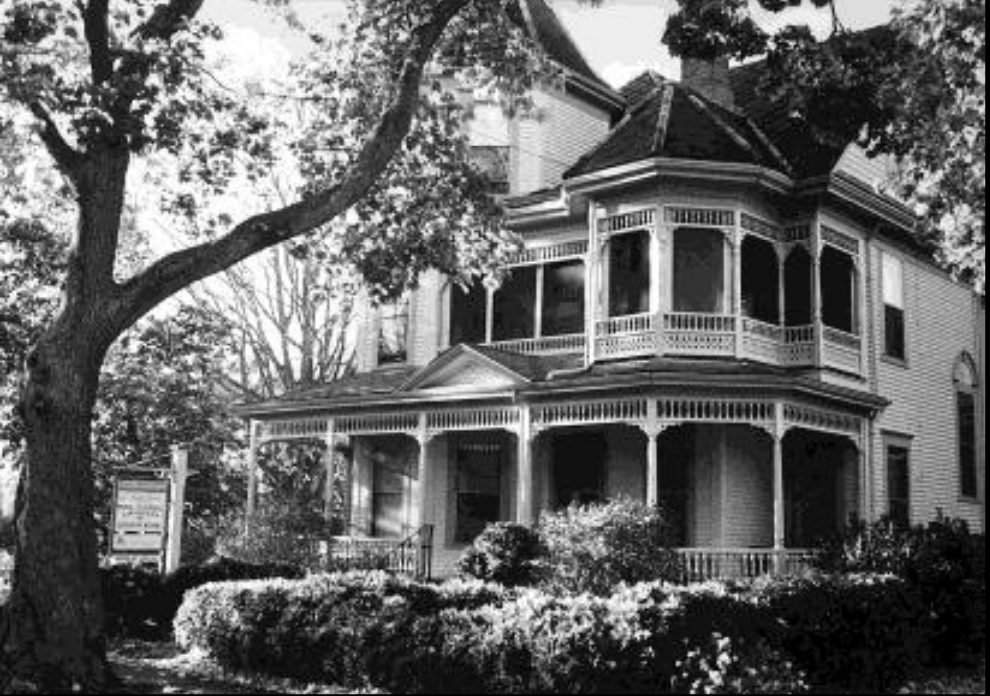
9 Cottage Street
On the corner of Cottage and Front Streets stands the 1891 Music Hall, which was designed in the Queen Anne style by Boston architect William Gibbons Preston. Constructed of red brick with terra cotta and rock-faced brownstone trim, the Queen Anne Music Hall at 164 Front Street is characterized by asymmetrical massing, its main facade is dominated by a porte-cochère and broad, typically Queen Anne gable. The Music Hall was funded by Elizabeth Pitcher Taber, the town’s great, late nineteenth century benefactress who founded Tabor Academy. She paid for local cemetery improvements, as well as the Congregational chapel on Main Street. The construction of the Music Hall was necessitated by Mrs. Taber’s displeasure with the use of her Congregational Chapel on Main Street for amateur theatricals and music programs.
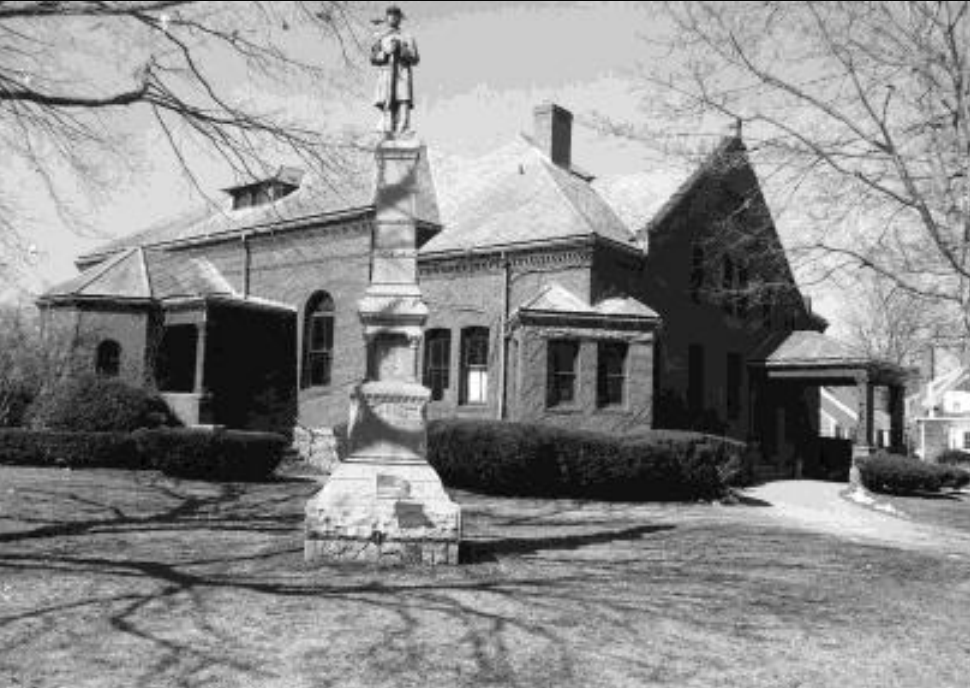
9 Cottage Street
In front of the Music Hall is the town’s only example of Civic sculpture, the columnar cast iron Soldiers Memorial (1890s, above). Across Front Street from the Music Hall is a marble, Elizabeth Pitcher Taber-donated watering trough for the horses of late Victorian era Marion.
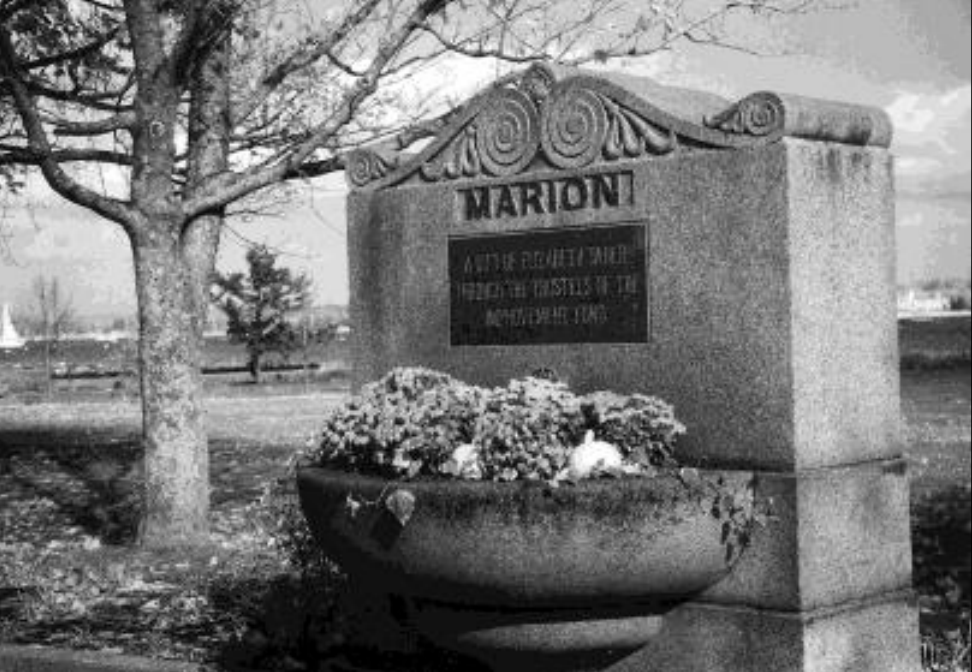
Turning right on to Front Street, the walking tour continues toward Main Street. Of the town center’s streets, Front Street possesses the most varied collection of Music Hall building types..
160 Front Street was built c.1815-1820. According to H. Edmund Tripp, the house incorporates the timbers of a salt works destroyed in the 1815 Hurricane. The salt industry in Marion began in 1806 and continued to operate until the Civil War. During the early 1820s, Marion’s principal export was salt. The production of salt by the evaporation of saltwater continued in Marion long after other communities folded their works as the result of competition from salt mining. Encompassing wind mills, wooden pipes and square vats, salt works were ephemeral structures, with only a very few surviving in museums on Cape Cod.
Owned by J. S. Gorham in 1855 and the estate of C. H. Damon during the early 1900s, 158 Front Street (photo not available) was operated during the Great Depression as “a typical New England home open to tourists.” A Wareham Courier article dated July 17, 1931 explains that, “the Rosamond Inn, at Cottage and Front streets, Marion has thrown open its doors to tourist travel and those who have read of New England hospitality, the homey features of the abode and the traditions handed down from the early settlers, will enjoy this hostelry’s outstanding features such as delicious meals and large, comfortable and unusually pleasant rooms.”
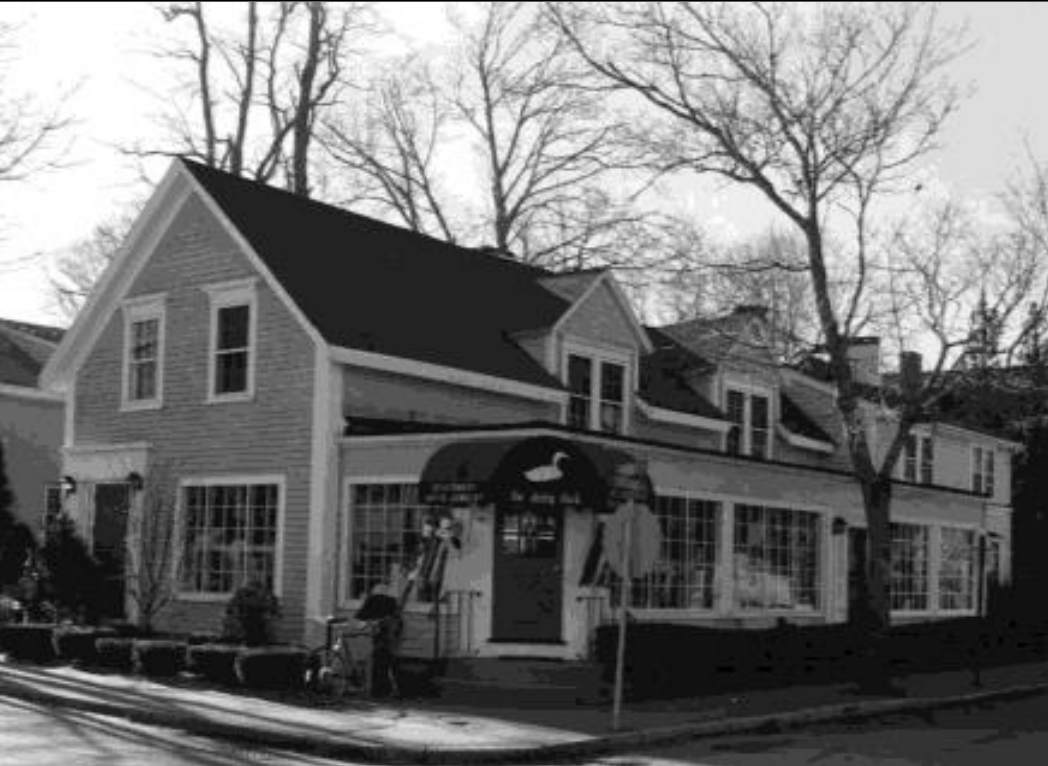
160 Front Street
Handy’s Tavern at 152 Front Street in the heart of the commercial area, remains mostly unspoiled. Built in 1812, as a ‘stop-over” on the way to New Bedford and Plymouth, this two story, five-bay by two-bay wood shingle clad residence was a popular gathering place for mariners after completing a day’s work on the waterfront or celebrating the successful conclusion of a voyage. The coming of the railroad Marion in 1855 effectively terminated operations at Handy’s Tavern. By that time, it was owned by former whaling Captain Ben Handy, who commanded a famous whaler called the Admiral Blake.
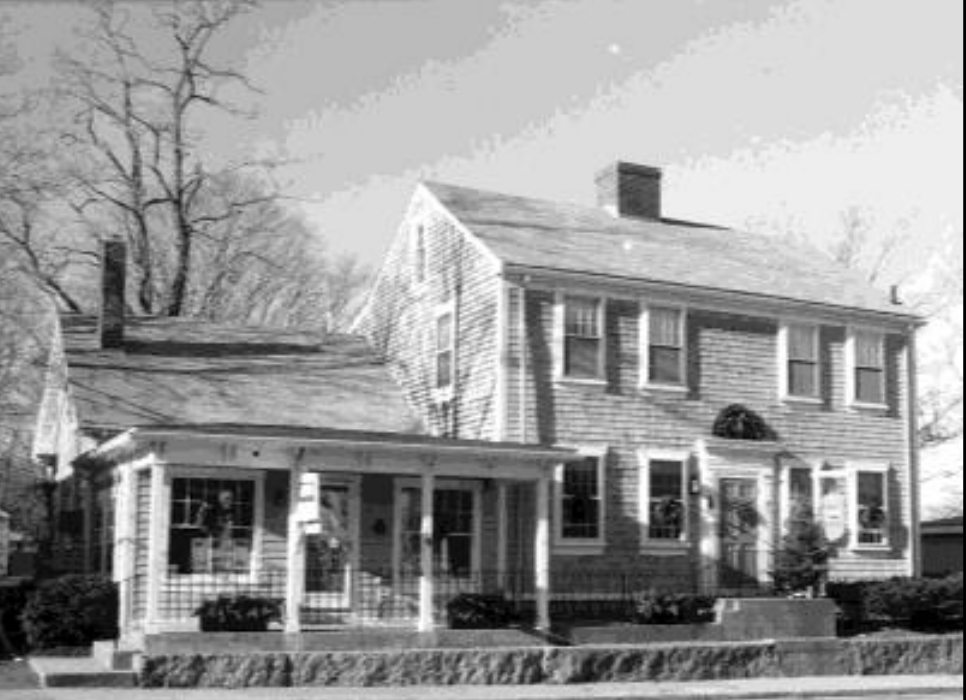
152 Front Street
More than any other, the building at 140 Front Street symbolizes Wharf Village as an important new focus for the spiritual, commercial and social life of Marion. Currently the Marion General Store, it was built and served as the Congregational Meeting House (1794-1799), its construction owed, in part, to funding provided by local entrepreneur George Bonum Nye. The completion of the Meeting House represents Marion’s first step toward independence from the “mother town” of Rochester; independence that was still a half-century in the future. For the first time since the early 1700s, the town folk would not have to travel to Rochester Center to partake in religious services. During the 1840s, the building was updated with Greek Revival elements such as corner pilasters and a pedimented attic.
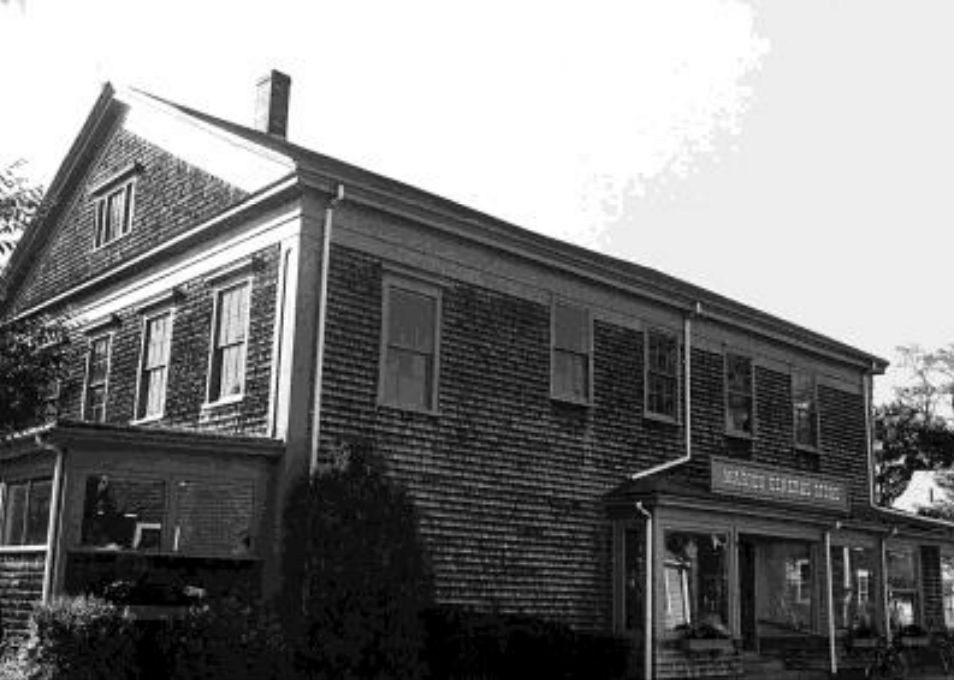
140 Front Street
Selected Bibliography:
Blumenson, John J. G., Identifying American Architecture. A Pictorial Guide to Styles and Terms, I6QQ-1945. American Association for State and Local History,
Nashville, 1977
Harris, C. M. Historic Architecture Source Book. Mc Graw Hill, Inc., New York, 1977
Gordon, Edward, Final Report, Cultural Resources Survey of Marion. MA. Massachusetts Historical Commission and the Marion Historical Commission, 1998 ri
Karr, Ronald Dale, The Rail Lines of Southern New England, A Handbook of Railroad story Branch Line Press. Hi Pepperell, MA, 1995
McAlester, Virginia and Lee, A Field Guide to American Houses. Alfred A. Knopf, 1984
Quinn, William P., The Saltworks of Historic Cape Cod. Parnassus Imprints, New York, 1993
Robinson, William K, Abandoned-New England. Its Hidden Ruins and Where to Find Them. New York Graphic So ety, N.Y., 1978 ci
Rosbe. Tudith Westlund. Marion, Images of America series. Arcadia Publishing, Charleston South Carolina, 2000
Schuler, Stanley, Saltbox and Cape Cod Houses, Schiffer Publishing Ltd., West Chester, PA, 1988
Scully, Vincent J., The Shingle Style and the Stick Style. Yale University Press, New Haven, 1 55 9
Somers, O. H. Sommers, Three Centuries of Marion Houses. Sippican Historical Society, 972 1
Tripp, H. Edmund, Reflections on a Town, Marion MA., Sippican Historical Society, 1991
Walker, tester, American Shelter, An Illustrated. Encyclopedia of the American Home, The Overlook Press, Woodstock, New York, 1981
Whiffen, Marcus, American Architecture Since 1780. A Guide to the Styles. M.I.T. Press, Cambridge, MA, 1969.

